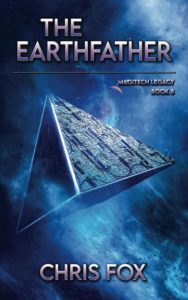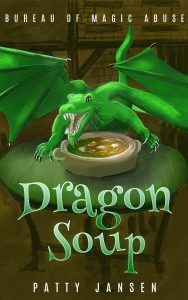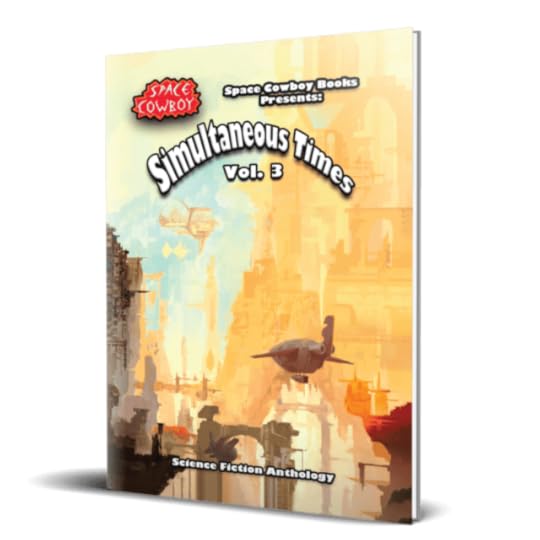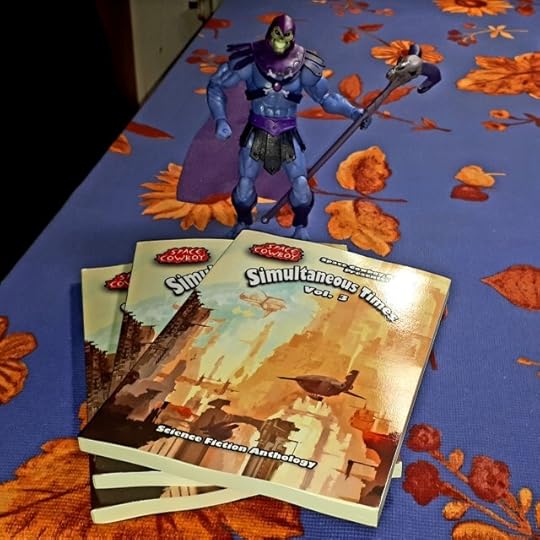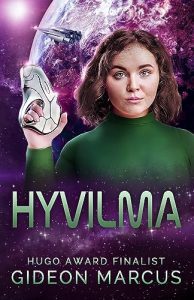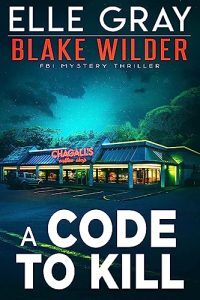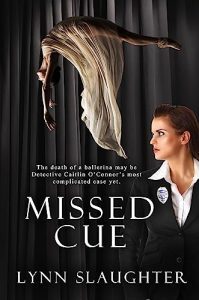Cora Buhlert's Blog, page 9
September 29, 2023
Indie Speculative Fiction of the Month for September 2023

It’s that time of the month again, time for “Indie Speculative Fiction of the Month”.
So what is “Indie Speculative Fiction of the Month”? It’s a round-up of speculative fiction by indie and small press authors newly published this month, though some August books I missed the last time around snuck in as well. The books are arranged in alphabetical order by author. So far, most links only go to Amazon.com, though I may add other retailers for future editions.
Once again, we have new releases covering the whole broad spectrum of speculative fiction. This month, we have urban fantasy, epic fantasy, cozy fantasy, sword and sorcery, paranormal romance, paranormal mystery, space opera, military science fiction, post-apoalyptic fiction, science fantasy, horror, dragons, werecats, fox shifters, bigfoot, starships, space pirates, mage queens, deadly dreams, reality bending dance clubs, crime-busting witches and much more.
Don’t forget that Indie Speculative Fiction of the Month is also crossposted to the Speculative Fiction Showcase, a group blog run by Jessica Rydill and myself, which features new release spotlights, guest posts, interviews and link round-ups regarding all things speculative fiction several times per week.
As always, I know the authors at least vaguely, but I haven’t read all of the books, so Caveat emptor.
And now on to the books without further ado:
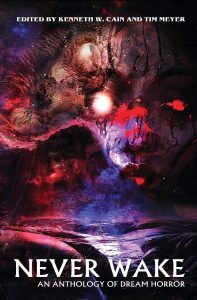 Never Wake: An Anthology of Dream Horror, edited by Kenneth W. Cain and Tim Meyer:
Never Wake: An Anthology of Dream Horror, edited by Kenneth W. Cain and Tim Meyer:
Have you ever wondered where we go when we dream? Why not let this breath-taking dream horror anthology guide you to worlds beyond the norm.
Since the beginning of time, people have argued the meaning of dreams. Are they symbolic visions that hold great meaning and personal significance? Are they portals into other worlds? Or are they just a series of random events our mind shows us when we fall asleep? Whatever the case, this much is true—the mind can be a scary place to venture, even for a few hours.
NEVER WAKE is an anthology of dream horror, bringing you several mind-bending tales of nightmares, hallucinations, and phantasmagoria from some of the hottest talent in horror fiction. But don’t worry—when you (wake up screaming) flip the last page, just remember to tell yourself, “It was only just a story…”
Unless it wasn’t.
Featuring an introduction from Sadie “Mother Horror” Hartmann and stories from: Cynthia Pelayo, Philip Fracassi, Gwendolyn Kiste, Eric LaRocca, Lee Murray, Todd Keisling, Laurel Hightower, and many more!
Where do we go when we dream?
Proudly represented by Crystal Lake Publishing—Tales from the Darkest Depths
 The Denverines: Ashes to Ashes by Declan Conner:
The Denverines: Ashes to Ashes by Declan Conner:
When everything climate survivalist Joe Cole holds dear in life is ripped from him, he will have to reclaim what he loves or die trying.
In a period of severe drought and near extinction of humanity, survivalist Jack Cole returns from scavenging to find his parents slaughtered, and Denverines soldiers have abducted his pregnant wife and child as birther stock for the citadel of Denver.
He vows to enter the citadel fortress of Denver to rescue them. But first he will have to overcome his own psychological demons, his lack of trust, and the bleak environment, in a journey filled with danger at every turn and to defeat the Denverines who have new orders. New communities are to be formed outside the citadels. To protect them, the president commands the Denverines to slaughter those on the outside with knowledge of the old ways of society.
When Jack teams up with and leads a group of exiles in his quest to rescue his family, if they fail, Jack’s failure will be a death sentence, not just for himself, but for all survivors in the wastelands.
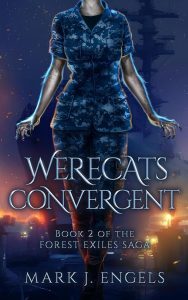 Werecats Convergent by Mark J. Engels:
Werecats Convergent by Mark J. Engels:
Defeated, conflicted, and on the run…
Born in an ethnic Chicago neighborhood following her family’s escape from Cold War-era Poland, were-lynx Pawly flees underground to protect her loved ones after genetically enhanced soldiers led by rogue scientist and rival werecat Mawro overrun her Navy unit in the Gulf of Oman. Pawly’s family seeks her out in a desperate gambit to return to their ancestral homeland and reconcile with their estranged kinsmen. But when her human lover arrives to thwart Mawro’s plan to weaponize their feral bloodlust, Pawly must face a daunting choice: preserve her family secrets and risk her lover’s life or chance her true nature driving him away forever.
Werecats Convergent is the second installment of the Forest Exiles Saga featuring the modern-day remnant of an ancient clan of werecats, torn apart as militaries on three continents vie to exploit their deadly talents. Stories which fans of Patricia Briggs’ Mercy Thompson franchise and Brad Magnarella’s Blue Wolf series can sink their teeth into!
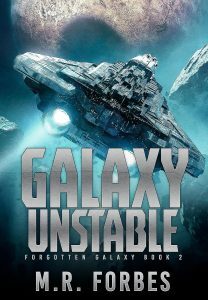 Galaxy Unstable by M.R. Forbes:
Galaxy Unstable by M.R. Forbes:
Left stranded, his starship’s life support failing, Caleb initiates a distress signal, hoping that help will arrive before his time is up. Only the response to his plea isn’t what he had in mind…
Assuming command of an infamous pirate vessel, Caleb sets his sights on shaping the unruly and unpredictable crew into a skilled fighting force. It won’t be easy, but if Caleb wants to prevent the Legion from cementing their tyrannical grip on the galaxy, he’ll need to knuckle up, double down, and risk everything to make it happen.
An ancient legend. A mysterious evil. And – the mead of poetry?
Liss Forlatt and Idun Wintermoon are on vacation at a beautiful villa retreat, a place as famous for its legendary beginnings as its year-round sunshine.
Technically, they’re the protection detail for the newly married jarl of Little Eerie and his wife. But in a place where rainclouds are the biggest threat on any given day, it might as well be a vacation.
Until a man winds up dead in connection with an ancient fable – the mead of poetry, the supposed font of divine inspiration that guides all poets and writers.
The pair must unravel fact from fiction, myth from history – and avoid the blade of a particularly nasty killer in the process.
Our Sector is Gone
We’ve discovered Terra, but the cost is bitter. All that remains is the Vagrant Fleet, carrying the refugees from every world.
Earth is our only hope, but their leaders don’t even believe in magic. We also have to convince the earth flight protecting them that we’re not hostiles. Did I mention the dread fleet is right behind us led by a dark god who seems to have a real hate-boner for Xal’Aran?
If we’re going to win, then we must harness the most powerful Catalyst in existence, the Eye of Om. We must fulfill a prophecy millions of years in the making, and find a way to elevate Aran and Nara to the Aranara, guardian of the Eye.
Anything less means complete annihilation, and if we fail here then we lost not just our own universe, but every reality as the dark titan breaks free and shatters the Great Cycle.
I cannot let that happen. I will not. Prophecy can be solved like a riddle, and somehow, I am going to find a way to outsmart them all.
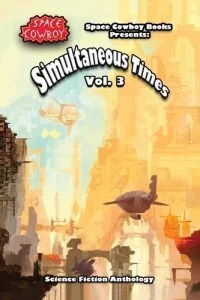 Simultaneous Times Volume 3, edited by Jean-Paul Garnier:
Simultaneous Times Volume 3, edited by Jean-Paul Garnier:
Space Cowboy Books Presents: Simultaneous Times Vol.3 Science Fiction Anthology. 16 wonderous stories of science fiction by authors from all over the world! From alien invasions to sentient planets to intergalactic species, this book has it all. Featuring stories from the two-time Hugo Award longlisted podcast Simultaneous Times, as well as stories appearing for the first time, this collection spans multiple generations of science fiction authors and covers a wide variety of SF styles and themes.
With stories by Jonathan Nevair, F. J. Bergmann, Brent A. Harris, Gideon Marcus, A. C. Wise, Tara Campbell, David Brin, Robin Rose Graves, Renan Bernardo, Christopher Ruocchio, Toshiya Kamei, Todd Sullivan, Susan Rukeyser, Ai Jiang, Cora Buhlert, Michael Butterworth. Cover art by Austin Hart. Edited by Jean-Paul L. Garnier
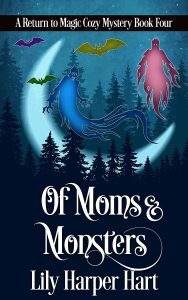 Of Moms and Monsters by Lily Harper Hart:
Of Moms and Monsters by Lily Harper Hart:
Maddie Graves-Winters is looking forward to a week of relaxation with her best friends. She had no idea a camping trip would be so stressful, however. She might have been picturing s’mores and ghost stories around the campfire, but the world has other plans.
Having her best friends Ivy Morgan-Harker, Harper Harlow-Monroe, and Rowan Gray-Davenport—as well as their husbands and children—around for a full week is her idea of bliss. There’s just one little problem.
Maddie doesn’t consider herself a suspicious person by nature, but when one of the college-aged girls at a nearby campsite goes missing—and nobody seems to care—she’s intrigued. Then, when a mother at a different campsite also appears to have disappeared in the middle of the night, she’s officially on the case.
Maddie and her friends can’t seem to help themselves from investigating. Their husbands are another story. They’re convinced the women are making things up in their heads.
Who will turn out to be right? And if it’s the women, what happens when they draw a potential killer’s attention to their campsite?
The group is strongest when they’re together. But this trip might be the death of one of them.
Plain version; for the illustrated version, see the author’s website.
When Perrin was so desperate that he applied for a job with the Bureau of Magic Abuse, there were two things he didn’t realise. One, that he might actually get the job and two, that it would involve working with magic sniffers.
And what an annoyance the creatures are. They keep him up at night, need to feed on expensive fresh fruit and cause him embarrassment.
A new inn opens in town and patrons flock to it. Perrin checks it out for forbidden magic, finds none but something doesn’t add up. Is it the stranger, clearly a wizard, who makes little effort to cover up his illegal activities? Is it the owner of the new inn, who can’t possibly have accumulated enough money to buy the place? Or is it the unfailingly raving reviews?
Something fishy is going on, and his boss at the Bureau doesn’t even want him to investigate. But Perrin has never let that stop him.
DARK FACTORY opened the doors to a reality-bending dance club, an online immersive portal, and the feeling that the whole world is on the brink of something new. DARK PARK takes you there.
DARK PARK follows visionary filmmaker Sergey Kendricks as he tracks Ari Regon and Felix the DJ through the fever and chaos of stardom and celebrity culture, while Max Caspar quests deeper into the unstable gaming landscape of Birds of Paradise: pursued and idolized by fans, acolytes, haters, and schemers, all dazed by beauty and searching for the end of the world.
DARK PARK is the encore to DARK FACTORY, Kathe Koja’s wholly original novel from Meerkat Press, that combines her award-winning writing and her skill directing immersive events, to create a story that unfolds on the page, online, and in the reader’s creative mind. www.Darkfactory.club
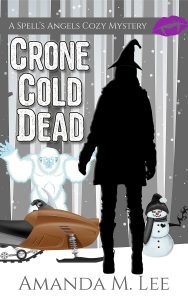 Crone Cold Dead by Amanda M. Lee:
Crone Cold Dead by Amanda M. Lee:
Scout Randall’s life has taken more turns than she was ready for, and it’s a new dawn in Hawthorne Hollow.
Her parents have arrived on the scene, and it turns out, they’ve been hiding in the shadows for years waiting for her.
The prophecy that foretold her winning what should be an unwinnable war, has enemies crawling out of the woodwork.
And, worst of all, she’s grappling with the realization that one of her own has betrayed her.
It’s too much for Scout to deal with, which means that the snowmen popping up around town and acting like sentries are barely a blip. When Bigfoot joins the fray, however, Scout realizes trouble is afoot.
All Scout wants is a few weeks to catch her breath. That’s not in the cards. Her life is starting to spiral, and now that she knows who the enemy is, the only thing she’s certain of is that she doesn’t have the strength to fight him.
Hawthorne Hollow is a magical nexus, and all the players are lining up. The ultimate fight isn’t far away, so when new faces appear, it’s easy to question if they’re friend or foe.
Who will come out victorious?
 Imperial Hijacker by Andrew Moriarty:
Imperial Hijacker by Andrew Moriarty:
Fleeing a smashed rebellion and near execution by their supposed allies, Dirk, Gavin, Dena and Ana abandon Scruggs and Lee during battle. When local medical treatment isn’t enough, Lee surrenders to the Imperials and arranges to surrender to Devin’s ship to save Scruggs’s life. When a botched meet-up leaves them all in Devin’s custody and surrounded by his Marines, it looks like time’s up for our heroes. But Devin gets startling news, and it’s not what it says, but what it doesn’t that worries him. He has a proposal of his own for Dirk and company. They’ll get Scruggs and what they want, but they might have to change sides!
If you like Galactic Empires, honorable enemies, and snappy dialog, this one’s for you!
Jack and Cameron have a good thing going. Jack is a burned out reporter and Cam is a fox shifter who gives him tips. They also meet up to play pinball…and to have sex. It’s a nice arrangement, no messy feelings involved, no pressure that neither one of them needs.
Cam is frightened by the idea of falling in love—been there, done that, got the scars to show for it—and Jack’s last relationship ended in a painful breakup. But things have been changing lately.
When there’s only one guy in the world you really want, is it going to work to keep pretending it’s just casual?
 Mage-Queen’s Thief by Glynn Stewart:
Mage-Queen’s Thief by Glynn Stewart:
She’s supposed to find a husband.
He’s supposed to steal a shuttle.
They’re each other’s only hope.
Kiera Alexander is the Mage-Queen of Mars, ruler of a hundred worlds and the protector of humanity. She is also unmarried and in desperate need of an heir—a duty that has left her traveling the Core Worlds of the Martian Protectorate aboard the luxury liner Extravagant Voyage.
Her mission? Meeting every eligible bachelor Mage that can be found.
Barry Carpentier’s only interest in the Queen’s traveling show is the strange shuttle hidden aboard Extravagant Voyage. The unique spacecraft, the smallest jump-capable ship he’s ever heard of, is worth a small fortune to the right buyer.
Like the one sending him aboard Extravagant Voyage.
A thief doesn’t want to meet the Mage-Queen of Mars—but when a thief accidentally inserts himself into galactic politics, neither of their lives will continue unchanged…
September 28, 2023
Indie Crime Fiction of the Month for September 2023

Welcome to the latest edition of “Indie Crime Fiction of the Month”.
So what is “Indie Crime Fiction of the Month”? It’s a round-up of crime fiction by indie authors newly published this month, though some August books I missed the last time around snuck in as well. The books are arranged in alphabetical order by author. So far, most links only go to Amazon.com, though I may add other retailers for future editions.
Our new releases cover the broad spectrum of crime fiction. We have cozy mysteries, small town mysteries, historical mysteries, Jazz Age mysteries, paranormal mysteries, crime thrillers, legal thrillers, conspiracy thrillers, adventure thrillers, romantic suspense, police officers, FBI agents, amateur sleuths, assassins, serial killers, missing persons, murdered tea shop owners, bigfoot crime-busting witches, crime-busting socialites, crime-busting journalists, murder and mayhem in London, Florida, California, Arizona, the Midwest and much more.
Don’t forget that Indie Crime Fiction of the Month is also crossposted to the Indie Crime Scene, a group blog which features new release spotlights, guest posts, interviews and link round-ups regarding all things crime fiction several times per week.
As always, I know the authors at least vaguely, but I haven’t read all of the books, so Caveat emptor.
And now on to the books without further ado:
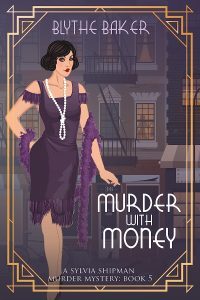 Murder With Money by Blythe Baker:
Murder With Money by Blythe Baker:
When Sylvia’s sister disappears unexpectedly, Sylvia doubts the official story. Joan wouldn’t run off to California to become a film star without first saying goodbye to her family. Clearly, she’s in some sort of danger and it’s up to Sylvia to find out what.
But can Sylvia set aside her doubts about her mysterious butler in order to enlist help from Miles when she needs it most?
 Chocolate Dipped Intrigue by Beth Byers:
Chocolate Dipped Intrigue by Beth Byers:
Long time friend of Violet Carlyle, that rogue Smith, and Jack Wakefield, Denny Lancaster is a devoted husband, a father to two, and an avid lover of crime. He’s also a little addicted to chocolate.
So he notices when things change at his favorite chocolate shop. Convinced something is amiss, Denny delves right in. This time on his own. And discovers that maybe the time has come for him to be the hero.
 Josephine West and the Unexpected Corpse by Beth Byers and Ann Warren:
Josephine West and the Unexpected Corpse by Beth Byers and Ann Warren:
Josephine West is broken after losing her husband during the Great War. She spends her days writing nonsense articles for the local newspaper and evenings avoiding the suitors her mother pushes her way.
Then, Josephine discovers a dead body in beautiful Carmel-By-the-Sea, California. She’s determined to both be the one who solves the murder and the one who publishes the story. Can she do it when everyone would try to stop her? She thinks she can, and she’s sure no one else will beat her to the truth. The only question is whether the chase will put her at risk?
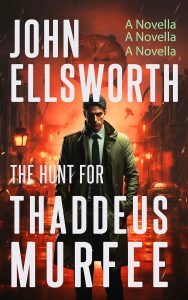 The Hunt for Thaddeus Murfee by John Ellsworth:
The Hunt for Thaddeus Murfee by John Ellsworth:
In the heart-pounding legal thriller “The Hunt for Thaddeus Murfee,” acclaimed author John Ellsworth introduces readers to the brilliant and resourceful attorney, Thaddeus Murfee, whose life takes an unexpected turn when he crosses paths with the cunning and dangerous criminal, Johnny Seventeen.
The story begins with a shocking incident—a bar room shouting match turns fatal when Johnny Seventeen pulls out a gun and shoots a man in cold blood. Arrested and charged with murder, Johnny hires Thaddeus Murfee, known for his unparalleled courtroom skills, to defend him against the charges. As the trial unfolds, tensions rise, and the truth becomes increasingly elusive. The first trial ends with a hung jury, leaving the case open for a second trial.
With the weight of Johnny Seventeen’s conviction hanging over him, Thaddeus discovers that the stakes are higher than he ever imagined. Johnny, consumed by a thirst for revenge, breaks out of jail and becomes a relentless predator, determined to track down and eliminate the one man standing between him and freedom: Thaddeus Murfee.
Forced to abandon his comfortable life and go on the run, Thaddeus finds himself in a race against time. As Johnny’s pursuit grows more relentless, Thaddeus must rely on his wit, legal acumen, and survival instincts to outmaneuver the relentless villain. With each passing moment, the line between justice and survival blurs, forcing Thaddeus to confront his own limits.
In “The Hunt for Thaddeus Murfee,” readers will be captivated by the intricate twists and turns of the legal world as they follow Thaddeus Murfee’s desperate struggle for survival. Packed with suspense, courtroom drama, and a gripping cat-and-mouse chase, this gripping legal thriller will keep you on the edge of your seat until the very last page.
Detective Ryan Boone thought the simple jewelry heist was an open-and-shut case. That is until he discovers an unknown drug, and this minor crime he was investigating may be tied to a string of seemingly unconnected murders.
Meanwhile, Mel Parker, unscrupulous leader of a less-than-legal high-end escort service, stumbles across the same pills. On top of protecting her “investment,” she has her own reasons for attempting to unravel the mystery behind the medication.
Ryan knows someone has the answers he seeks, and Mel can’t come forward. To complicate things further, five other women are implicated in the murders despite most having never met.
As the trail turns up as many mysteries as resolutions, Ryan and Mel must discover the twisted connection before someone else ends up dead.
 Memories of the Falls by Elle Gray:
Memories of the Falls by Elle Gray:
It’s summertime at the Falls, and this season revenge tastes even sweeter…
Sheriff Spenser Song thought she would get a much-needed break after aiding FBI agent Blake Wilder on an international trafficking ring.
Shortly upon her return to the Falls and to Ryker, the place is once again in an uproar.
When the town’s star athletes are found dead due to a drug overdose.
Once again, it’s up to Spenser with a bit of aid from Ryker to get to the bottom of the string of drug related deaths.
Mean girls, star athletes, and class clowns.
Leaving high school is easy, but the memories you make there will always stay with you.
 Of Moms and Monsters by Lily Harper Hart:
Of Moms and Monsters by Lily Harper Hart:
Maddie Graves-Winters is looking forward to a week of relaxation with her best friends. She had no idea a camping trip would be so stressful, however. She might have been picturing s’mores and ghost stories around the campfire, but the world has other plans.
Having her best friends Ivy Morgan-Harker, Harper Harlow-Monroe, and Rowan Gray-Davenport—as well as their husbands and children—around for a full week is her idea of bliss. There’s just one little problem.
Maddie doesn’t consider herself a suspicious person by nature, but when one of the college-aged girls at a nearby campsite goes missing—and nobody seems to care—she’s intrigued. Then, when a mother at a different campsite also appears to have disappeared in the middle of the night, she’s officially on the case.
Maddie and her friends can’t seem to help themselves from investigating. Their husbands are another story. They’re convinced the women are making things up in their heads.
Who will turn out to be right? And if it’s the women, what happens when they draw a potential killer’s attention to their campsite?
The group is strongest when they’re together. But this trip might be the death of one of them.
 Crone Cold Dead by Amanda M. Lee:
Crone Cold Dead by Amanda M. Lee:
Scout Randall’s life has taken more turns than she was ready for, and it’s a new dawn in Hawthorne Hollow.
Her parents have arrived on the scene, and it turns out, they’ve been hiding in the shadows for years waiting for her.
The prophecy that foretold her winning what should be an unwinnable war, has enemies crawling out of the woodwork.
And, worst of all, she’s grappling with the realization that one of her own has betrayed her.
It’s too much for Scout to deal with, which means that the snowmen popping up around town and acting like sentries are barely a blip. When Bigfoot joins the fray, however, Scout realizes trouble is afoot.
All Scout wants is a few weeks to catch her breath. That’s not in the cards. Her life is starting to spiral, and now that she knows who the enemy is, the only thing she’s certain of is that she doesn’t have the strength to fight him.
Hawthorne Hollow is a magical nexus, and all the players are lining up. The ultimate fight isn’t far away, so when new faces appear, it’s easy to question if they’re friend or foe.
Who will come out victorious?
 Press Releases & Puff Pieces by Amanda M. Lee:
Press Releases & Puff Pieces by Amanda M. Lee:
Avery Shaw is looking forward to a quiet—but entertaining—day in court when a furious plaintiff takes off after losing what Avery believes to be one of the funniest cases she’s ever covered. Avery gives chase because she wants an interview, and her life is thrown into turmoil during the melee that follows.
Alice Wendell likes to sue people. She’s made a name for herself suing neighbors, police officers, dogs, and even dates. That’s why, when a car is aimed at her in downtown Mount Clemens, it’s not exactly a surprise. The ensuing explosion is, however, and Avery is there for the unfortunate aftermath.
When she wakes in the hospital following a serious head injury, she finds Alice is dead…and maybe not from the blast that took out the clocktower downtown.
Once back on her feet, Avery is determined to chase the case. Her boss, husband, and the very annoyed sheriff in charge of the death investigation have other plans…and they involve Avery being pushed to the puff piece beat until she’s no longer shaky from the explosion.
Avery Shaw is not going down without a fight, however. She’s determined to get to the bottom of things, even if she dies in the process.
There’s something hinky going on at the biggest hospital in the county, and Avery won’t stop until she knows exactly what that something is. That puts a target on her back, and the individual aiming at that target just might have the upper hand.
It’s a fight to the finish for Macomb County’s favorite reporter. Will she survive to claim yet another win, or is this finally the end for Avery Shaw?
David Centrelli is a junior business development executive at a pharmaceutical company in Richmond with no military training or criminal record whatsoever…but an innocent knock on the door one typical Monday morning changes his life forever.
Thrust into a world of unbelievable accusations, outrageous claims and danger he’s only seen in the movies, he’s told that his best friend’s death two weeks earlier was no accident, and that his buddy has a message for him from the grave. As skeptical as he is, clues far too specific to be coincidental keep coming, and soon his own home is engulfed in flames. When the perpetrator contacts him, he learns that not only are the accusations legitimate, but that people trained to eliminate problems have labeled him one.
Blackmailed by decisions he made years ago, informed that his brother has been kidnapped, and threatened with a future not even his worst nightmare could imagine, the temptation to give up what he knows and disappear into affluent anonymity grows stronger by the second…until he learns that millions of lives depend on him trying to do the right thing. But can this ordinary businessman really escape death from experts trained to administer it and prevent a colossal calamity already set in motion by the highest levels of government.
 Behind the Mask by A.J. Rivers:
Behind the Mask by A.J. Rivers:
Every small town has its secrets.
This secret is worth taking lives for…
After saving Molly from a trafficking ring and reuniting with her mother, FBI agent Ava James feels as though she has found true happiness.
While having a family dinner Ava receives a call from an old friend, with some bad news.
Every Halloween, teen girls from the rural Vermont town are going missing.
Each year more than the last.
Did the teens simply run away from home? Or is something far more sinister at play?
With no bodies to be found, it seems as though the teens simply just vanished.
At her friends urging and with only 11 days until Hollow’s Eve, Ava goes to Pine Bend, Vermont to investigate the disappearances.
Phantom serial killer, smugglers, weird Wicca club, and annoying youth groups.
Pine Bend is a town full of weirdos.
And behind a mask, anyone can hide in plain sight.
 A Seller’s Market by Wayne Stinnett:
A Seller’s Market by Wayne Stinnett:
Six months out of high school and just days after finishing Marine boot camp, Jesse McDermitt is finally ready to unwind and have a little fun when he goes home on leave.
But everything Jesse remembers—his friends, his family, the sparkling beaches and familiar waters of the Caloosahatchee River and Pine Island Sound, even his faithful Lab, Molly, have all changed.
Only when he reunites with a boot camp buddy to explore the reefs of the Florida Keys and the oddly relaxing shallows of the backcountry does Jesse finally understand that it was he, himself, who had changed.
The two young men, enjoying life in paradise while on boot camp leave, soon find out that there are still pirates in those tropical waters. Only their galleons and corsairs have been replaced with offshore racing boats and motorcycles.
 Arrest the Alibi by Anne R. Tan:
Arrest the Alibi by Anne R. Tan:
My name is Cedar Woods, and I am a recovering ostrich. I have the unfortunate habit of burying my head in the sand. Newly divorced and penniless, I am cleaning my friends’ fancy McMansions to make ends meet while lawyering up for a financial audit on my ex-husband’s tech company.
When my Aunt Coco fell and broke her hip, I hightailed back to Mirror Falls. But things took a bizarre turn when I found out my Chinese aunt thought her new corgi was her husband’s reincarnated spirit, and she took the dog’s financial advice to invest her retirement money into a tea shop. Is she losing her mind, or am I being punished by my ancestors?
To make matters worse, a rival shop owner turns up dead, and Aunt Coco becomes the prime suspect. With the help of newfound friends, I must shift through the town’s secrets to exonerate my aunt and prepare the tea shop for its grand opening. But with a vicious murderer on the loose, I might be in over my head. Can I catch the killer before someone else gets hurt? Will I find the home I spent my entire life searching for?
This humorous cozy mystery will charm readers with its endearing characters, heartwarming family relationships, and an intriguing whodunit that will keep readers guessing until the end. Don’t miss out on the fun. Grab your copy now.
 The Girl Who Found Joy by Amy Vasant:
The Girl Who Found Joy by Amy Vasant:
Mason and Shee travel to Palm Beach to hunt a killer the FBI has nicknamed “Portia”—a type of spider more clever than a black widow. Portia finds a victim and someone to frame for his murder before disappearing with the money—the perfect crime.
Shee befriends their target but plans quickly unravel. A man stabbed to death, mysterious messages, a body washed ashore—all of it a little crazy to fit Portia’s style…
Do they have the wrong killer, or is this another of Portia’s tricks?
Shee and Mason must tap the Loggerhead crew to unravel the crime, but Portia’s web only grows more twisted…and deadly.
September 18, 2023
Foundation travels “Long Ago, Not Far Away” and blows up its own premise
Season 2 of Foundation is currently streaming, so I’m doing episode by episode reviews again. For my takes on previous episodes, go here.
Warning! There will be spoilers under the cut!
“Long Ago, Not Far Away” was a really good episode of Foundation. Well, at least ninety-five percent of it were really good. Unfortunately, the last five minutes or so not only ruined the episode, but the entire series.
But first things first. The episode begins with Cleon I or rather his hologram recounting the story of Demerzel and of how Cleon found her to Dusk a.k.a. Cleon XVI and Rue, who stumbled upon a secret room in the palace last episode.
We get a flashback to Cleon I as a young prince, son of the Empress and her consort. I don’t think the kid that plays young Cleon is the same kid that played young Dawn in the first two episodes of the series, which seems like an oversight. One day, while playing, little Cleon stumbles upon the hidden staircase and the hidden chamber, where he finds Demerzel, sliced into pieces and held in stasis. At first, he thinks she’s a display piece or statue, but Demerzel begins to speak. First she asks little Cleon to set her free and then, once she realises he’s a child, Demerzel promises Cleon to tell him stories, because she knows a lot of them.
Cleon never tells his parents about his encounter with Demerzel, but he keeps coming back for more stories about robots and humans, about the Empire and Earth. There’s a time jump and Cleon is a young man, now played by Cassian Bilton, who plays Dawn. His mother, the Empress, has just died and he will succeed her, but his advisers won’t let him out of their sight and Cleon is afraid he won’t be able to visit Demerzel anymore. Demerzel tells Cleon that he is the Emperor now and can do whatever he wants. She also tells him that she has been a general and has seen many things and would make a great adviser, if Cleon were only to let her go, but Cleon won’t have any of it. He still keeps on visiting.
There’s another time jump and Cleon is now middle-aged, played by Lee Pace. He finally deactivates the stasis mechanism and puts Demerzel back together, but he still keeps her imprisoned behind a force field, because she is a potentially dangerous robot. He also brings her clothes, so she won’t have to be naked anymore.
During Cleon’s meetings with Demerzel, we learn a bit more about her. She is eighteen thousand years old or was at the time of Cleon I and has been imprisoned for five thousand years. She uses the name Demerzel, because she has a female body now, but she had a different name and body once. I guess we all know what it was – she was called R. Daneel Olivaw once and had a male body. The one who imprisoned Demerzel was a former Emperor who was both fascinated by Demerzel and wanted to figure out how she worked, so he could build more robots (apparently, the Empire had already lost that ability by that point), and also delighted in torturing her. After he died, he kept her imprisoned and eventually forgotten, until little Cleon stumbled upon her.
Does any of this fit in with Daneel/Demerzel’s history in the books? Well, obviously there was no robot uprising in the books, because Asimovian robots do not rebel due to being bound by the Three Laws of Robotics. And no, the Three Laws cannot be switched off or altered as easily as they are here. But otherwise, this version of Daneel/Demerzel’s history does not explicitly contradict the books, because we simply never learn what R. Daneel Olivaw did between gaining telepathic abilities and appointing himself protector of the humanity at the end of Robots and Empire and when he pops up again on Trantor in the double role of Eto Demerzel, First Minister to Cleon I (who is male in the books), and journalist Chetter Humin thousands of years later. And what we learn about Daneel/Demerzel’s origin does match the books, as the Stars End podcast and Paul Levinson both point out.
Fast forward once again and Cleon is an older man, now played by Terrance Mann, who plays Dusk. Demerzel asks Cleon about his impending marriage, but he tells her that he called it off, because he only wants one woman in the universe, namely Demerzel. Demerzel tells him that he needs an heir and that she can’t provide that, but Cleon has a solution for that problem as well, namely the genetic dynasty.
Cleon finally lets Demerzel out of her forcefield cage. He asks her if robots had to obey certain laws and if the first law was that a robot must not harm a human. Demerzel replies that this was so. Before she can do anything more, Cleon installs a patch in her positronic brain. Where in the galaxy he found someone who could program such a patch – Demerzel is the last robot, after all, and even five thousand years ago, humanity had lost the skills and knowledge to build robots – we don’t know? I guess the writers hope that we won’t wonder about this.
The patch forces Demerzel to obey Cleon and prevents her from harming him, though she can (and will) hurt other people. Demerzel tells Cleon that this isn’t freedom, but Cleon is oblivious to her distress and unhappiness and tells her that she will always be there right by his side, right by the throne, ruling the galaxy with him. Cleon even drops down to his knees to offer Demerzel a universe she never asked for and a role she does not really want. The various Cleon clones of the genetic dynasty will be their children. Of course, the memories of the Cleon clones must be edited, so they do not know what is going on. At any rate, Cleon I confirms what Dusk and Dawn figured out last episode – that the Cleons are just figureheads and Demerzel is the true ruler of the Empire.
Dusk is not at all thrilled at learning that he and his fellow Cleons have just been figureheads, but Rue reminds him that Demerzel’s Empire will be over along with the genetic dynasty, once Day marries Sareth. Of course, Cleon I, though dead and a hologram cannot let this happen. And since Dusk and Rue unwisely stepped into the forcefield cage, he just reactivates the forcefield, trapping them in a part of the palace no one else except for Demerzel (who is en route to Terminus with Day) even knows about. It’s quite possible that in a few centuries, once the Empire has fallen and Trantor is reduced to some peasants keeping cattle among the ruins and a bunch of telepathic nerds, someone will dig up the skeletal remains of Cleon and Rue.
Meanwhile on Ignis, Salvor Hardin has escaped from her telepath proof prison and she’s pissed. She heads for the temple, where Tellem Bond is about to reenact the end of The Testament of Dr. Mabuse with Gaal and knocks out a guard to steal his rifle. Then she storms the temple, where the mind transfer ceremony is about to reach its climax. Salvor uses the sonic devices that were used to cancel out her psychic abilities to knock out the Mentallics, grabs Gaal, who is already partially possessed by Tellem, and slaps her to drive out Tellem’s malevolent spirit. Then they make a run for the Beggar.
However, Salvor has only managed to knock out the Mentallics for a limited amount of time and once they recover, they set off in hot pursuit of Salvor and Gaal. Salvor tells Gaal to fire up the Beggar‘s systems, while she deals with the pursuers, chief among whom is Tellem’s right-hand man, the black guy with the scars who had tricked Salvor into believing he was her ex Hugo Crast before. This leads to a seemingly endless fight in the mud between Salvor and the scarred dude. And yes, that fight really does feel endless, especially since the episode cuts back to the mud wrestling several times, usually from scenes which are a lot more exciting than two people wrestling in the mud. Worse, scarred dude pulls the trick of appearing as Hugo and telling Salvor that he loves her several times. And Salvor falls for it again and again, hesitating at the crucial moment rather than taking out the scarred dude. This doesn’t really ring true, because Salvor is not stupid. And while she may have fallen for the Hugo trick once, after the first time, she’d know that “Hugo” was not real. Never mind that I also find it difficult to believe that Salvor loved Hugo so much, considering that she left him to travel 134 years into the future to search out a biological mother she’s never met at the end of season 1. The endless mud fight finally ends when Salvor lures the scarred dude into the Beggar’s airlock, seals it and vents the oxygen, suffocating him. And this time, she does not soften, when he turns into Hugo one last time.
Meanwhile, Gaal is firing up the Beggar‘s system, only to find herself faced with a very angry Tellem Bond. Tellem wants Gaal to surrender, because she still needs Gaal’s body, and uses her telekinesis to throw Gaal around the ship like a rag doll, while random consoles explode. Tellem then enters Gaal’s mind to find her worst fears. At first, she appears as Gaal’s father who tells his daughter how very disappointed he is that she left Synnax and has forsaken their fundamentalist anti-science religion and removed the stones from her cheeks. Gaal screams that he is not her father and the scene changes to Gaal’s flash forward to the Mule’s conquest of Terminus and Salvor’s death. Tellem clearly wanted to use a traumatic memory (in this case of something that hasn’t yet happened) to break Gaal, but the strategy backfires, when Tellem looks into the eyes of the Mule and screams, knocking her and Gaal back into the real world. This would seem to prove that Tellem is not the Mule herself, but may well know who he is. Either that or the Mule just out-mentalliced Tellem.
Salvor has made it into the Beggar by now and there is some more fighting as Tellem uses her telekinetic powers to throw Salvor and Gaal around like rag dolls. Honestly, the fight on Ignis goes on way longer than it should, considering that there are much more exciting things happened elsewhere. And then Hari Seldon the Second shows up – proving that he’s neither dead nor a hologram – and proceeds to bash Tellem’s brains out with a log, a scene that Paul Levinson finds quite satisfying. And in many ways it is, because Tellem Bond was a terrible person and scary villainess for all her faux hippy dippy niceness. Is this the end of Tellem Bond? Time will tell. After all, it’s possible that she pulled a Mabuse and sent her spirit into a new host body.
However, the IMO most interesting part of the episode happens in and around Terminus. The Imperial fleet under the command of Bel Riose is in orbit around Terminus, while Day and Demerzel are en route to Terminus and Hober Mallow and Brother Constant are prisoners aboard Bel Riose’s flagship. Hober asks Constant which prison cell was nicer, the one on Trantor or the one aboard Bel Riose’s ship. Constant replies that the cell aboard the ship is much more cozy.
Bel Riose himself comes to see them and we get yet another variation of the debate between Bel Riose and Ducem Barr in “The Dead Hand/The General”. In fact, Bel Riose actually utters the words “the dead hand of Hari Seldon” on screen. Bel Riose also agress that the Empire will fall eventually, but not just yet. Constant, ever the true believer, points out that maybe the spirit of Hari Seldon brought Bel Riose to Terminus, so he could see the Foundation and what they’re capable of with his own eyes and be convinced that the Foundation has more to offer than the Empire. After all, this is how the Foundation conquered the various worlds – Anacreon, Thesbis, Smyrno, Askone – it now controls, namely without bloodshed. Personally, I think that Constant grossly overestimates the appeal of Terminus, which is still a largely barren frontier outpost at this point, albeit one with very impressive technology. That said, Constant is not wrong either, because the best course of action for Bel Riose would be to defect to the Foundation and throw Day out of the nearest airlock. However, since Bel Riose is very much a tragic figure, he won’t do the logical thing out of misplaced nobility and disloyalty. And yes, considering that the show is ignoring the books in pretty much every other way, I’d hoped that maybe they’d ignore the books in the case of Bel Riose and his ultimate fate, too. But I fear we’ll have no such luck.
Bel Riose’s interrogation of Hober Mallow and Brother Constant is cut short when he is informed that Brother Day has arrived with Demerzel and Poly Verisof in tow and is about to dock with the flagship. So Bel Riose heads to the bridge to meet Day and Demerzel. He tells Day that they could end this conflict peacefully, since the Empire has the bigger fleet and the upper hand. Day actually agrees and decides that being known as “the Cleon who chose peace” would look good in the history books. So he will personally travel down to Terminus himself to accept their surrender. Demerzel very much disagrees with this idea, but Day overrules her. Bel Riose’s crew scans the surface of Terminus and find that there is a lot of power being consumed inside a specific building that appears to be a church.
Meanwhile on Terminus, Director Sernak (who gets a first name in this episode, Sev), Councillor Jorane Sutt, Jaim Twer, who is the new warden since Hari Seldon disintegrated the last one, and a bunch of citizens are standing in the town square, looking up to the sky and the battleships in orbit around Terminus. So they are finally aware of what is happening. Sernak orders the bald man we’ve seen a few times in the Terminus scenes – apparently his name is Brigadier Manlio – to go aboard the Invictus, the Imperial battleship the Foundation appropriated at the end of season 1.
Day lands on Terminus and disembarks his shuttle with Demerzel and Poly Verisof in tow. He is met by Director Sernak and his staff. Day tells the director that they are returning Poly Verisof to the Foundation as a peace offering. Director Sernak asks Day and Demerzel to come into the Foundation’s government building a.k.a. the converted spaceship on which the colonists arrived on terminus 150 years before. However, Day doesn’t want to go there and instead points at the building with the enormous power consumption. “That’s a church”, Sernak says, somewhat disconcerted. However, Day insists on going there. After all, he is but a humble pilgrim and which god would deny him visiting a church. Because Day going on a pilgrimage for someone else’s religion was such a great idea the last time around.
It’s very clear that the Foundationers don’t want Day to go into the “church”, because – surprise – it’s not a church at all. It’s a factory where the Foundation manufactures all of its miracle technology. Though for some reason, the place doesn’t even look like a twenty-first century factory – where you’d see fewer humans and a lot more industrial robots – but like a mid twentieth century assembly line. In fact, the place could be a 1940s wartime factory full of riveting Rosies (which would be oddly appropriate, considering when the original Foundation stories were written) only that the workers are all wearing monk’s robes.
So Day learns what everybody else already knows. The Church of the Galactic Spirit is a sham, science and high-tech disguised as religion. To say that Day is not pleased would be an understatement. He rants and raves and demands to know whatever happened to the Encyclopaedia the Foundation was supposed to compile. Director Sernak replies that there is no Encyclopaedia and that the Foundation has widened its scope, but that they’re still working to preserve and develop technology for the welfare of humanity. This is of course completely correct, though the Encyclopaedia Galactica does get created in the books and provides the epigraphs for every story or chapter. However, it doesn’t convince Day and he rants and raves some more.
Poly Verisof tries to calm Day down by pointing out that yes, he and his fellow missionaries are putting on a show to convince the rubes, but the spirit is real and psychohistory is real and it is inspiring the Foundationers to create and build weapons and tech way beyond the Empire’s capabilities.
“Convince me”, Day replies, “Put on a show. Convert me.” So Poly does put on a show and we get to see a scene from the books that I didn’t expect to get to see anymore at this point in the season, namely the iron into gold transformation from “The Wedge” (based on a real experiment from 1941). Now that particular scene has always been a personal favourite of mine, because it’s very cool and also a perfect example of how the Foundationers dazzle and bamboozle everybody else with science, so I’m really glad we got to see that scene. The transmutation device Poly Verisof uses is that ever popular SF movie prop, an ice cream maker. I’m not sure why ice cream makers are such popular science fiction film props, probably because they’re readily available, yet not something everybody has in their kitchen, and look suitably futuristic. Though the iron into gold ice cream maker in Foundation might simply also be a Star Wars reference.
Poly Verisof succeeds, too – well, it is science – and transforms Director Sernak’s chain of office (if that’s what it is – it’s an ostentatiously big pendant, at any rate) into gold. Unlike the elders on Askone, Day is not overly impressed, probably because he has plenty of gold himself. “Alchemy”, he exclaims and tells Poly that the atomic ashtray was a better gift.
Then someone accidentally knocks over a box full of personal forceshield bracelets and Day gets utterly furious, because only the Emperors are allowed to use such technology and yet the Foundation is selling knock-offs to anybody who can pay. “We’re not selling them, we’re giving them away”, a female missionary points out, which makes Day even more furious, because how dare the Foundation just give away something that Day always viewed as his privilege? And so Day stabs Director Sernak and orders his soldiers to capture the scientists, shoot the priests and missionaries and bag up all the Foundation tech which Day feels should belong to the Empire.
While all this is happening on Terminus, up in orbit Bel Riose and his bridge crew get their first glimpse of the Invictus. Initially, they think it’s a quaint relic from the Empire’s past, but then they realise that the Invictus is fully operational, when it starts firing at the Imperial fleet. And the Invictus packs a lot of fire power. The Empire fires back, while the Invictus is joined by a fleet of Foundation whisper ships. “I thought they were supposed to be merchants”, Bel Riose exclaims and scrambles his own fighter squad, commanded by Glawen Curr. Bel Riose even hands his dog tags (they’re still using dog tags in the far future?) to Glawen Curr for good luck, even though that sort of thing never bodes well for a character. And so we get that most un-Asimovian of science fiction trops, a giant space battle.
Now there actually are space battles in the original Foundation stories – however, they take place off page. Just as space battles were actually pretty uncommon during the so-called golden age of science fiction – the modern space battle is a phenomenon of the 1970s. That said, modern audiences expect to see a space battle, when there is one, so I don’t mind those scenes. Though I do mind the outcome, because even though the show has done a lot of work to make us sympathise with the Imperial fleet, I’ll still always be on the side of the Foundation.
The Foundation initially has the upper hand due to their superior technology. However, Glawen Curr figures out that the brain activity the Imperial scanners are detecting at the rear of every Foundation ship is not a second crewmember, but the ship’s central computer using artificial brain tissue and directs his squad to concentrate fire there. And so the Foundation whisper ships are destroyed one by one.
The Imperial fleet then concentrates its fire on the Invictus. Glawen Curr pulls a Star Wars style trench run and manages to fatally wound the Invictus. However, he’s no Luke Skywalker and so his fighter craft spirals out of control towards the surface of Terminus.
Meanwhile, back on the surface of Terminus, Day has set his sights on the Vault and wants to go there. Demerzel doesn’t want him to, but is once more overruled. Frustration with Day seems to be Demerzel’s constant state in this episode. Meanwhile, Poly Verisof, who has miraculously escaped the order to mass murder Foundation priests and is still alive, warns Day that Hari Seldon has his defences. And indeed, I hoped that the Vault would incinerate Day. Alas, no such luck, even though Day takes off his personal forceshield and armour, running around only in a gilded chainmail shirt with nothing underneath. Ouch, that’s got to chafe.
So Day, Demerzel and Poly Verisof make their way to the Vault, passing the flags planted around the Vault. Day asks what those flags mean and Poly replies that it’s a dare for the kids of Terminus. Then Day positions himself in front of the Vault and yells at Hari Seldon to come out and face him, only for Hari or rather his hologram to pop up behind him.
Hari invites Day and Demerzel into his study. It’s very clear that not only have Hari and Demerzel met, but that Hari knows what Demerzel is. And indeed, in Prelude to Foundation, Demerzel was the one who persuaded Hari to turn psychohistory into more than just a theory. Considering that this episode revealed that Demerzel has her own agenda, I wouldn’t be surprised if the same had happened in the TV series.
It’s also pretty obvious that Demerzel is the one Hari really wants to talk to and he actually addresses her though most of the discussion. Day is just there as an annoying appendix. Though Hari tries to persuade Day to call off the attack, because war between the Foundation and the Empire would only kill a whole lot of people, but wouldn’t change the outcome for the Empire in the long run. However, that’s very much not what Day wants to hear. Because Day is absolutely convinced that he has beaten Hari Seldon and his predictions of the fall of the Empire by abolishing the genetic dynasty and marrying Sareth.
Hari replies that outliers happen and are difficult to predict (foreshadowing the Mule?), but that Day isn’t one. And whether Day marries Sareth or not, it won’t change the fact that the Empire is destined to fall, though not yet. Indeed, it’s very typical of this Day that he focusses solely on Hari Seldon’s claim one hundred and fifty years ago that genetic dynasty means stagnation and eventual decay for the Empire, even though that was just one point in a long laundry list of things that are wrong with the Empire and clearly not the worst. Because the main problem with the Cleons is not that they’re clones, but that they are megalomaniac tyrants.
Hari also offers to show Demerzel how to operate the Prime Radiant, so Day can see the future for himself and can see when the Empire will fall. But once again, that’s not what Day wants. Instead, he wants Hari to admit that his math was flawed. And when Hari refuses to do that, Day leaves in a huff and orders Bel Riose to drop the stricken Invictus on Terminus. Bel Riose points out that a) crashing the Invictus onto Terminus would probabyl destroy the planet due to the Invictus’ singularity drive, and b) the overwhelming majority of people on Terminus are civilians and not a threat to the Empire. However, destroying Terminus is exactly what Day wants.
Day and Demerzel take a shuttle back to the Imperial flagship. Aboard, they happen to pass the cell where Hober Mallow and Brother Constant are still locked up. Hober calls Day “Yesterday”, which must sting, though it’s not the worst thing someone will say to Day in the course of this episode. Nonetheless, the damage is done. Day notices Hober and Constant and realises that Hober Mallow was the one who crashed Day’s execution ceremony – quite literally – and sicced a bishop’s claw on Day. “You smashed into my home and now I’ll smash into yours”, Day says and orders Hober and Constant to be taken to the bridge to get a balcony seat for Day’s final attack on Terminus.
While they’re heading for the bridge, Demerzel suddenly gets a message – likely triggered by Dusk and Rue stumbling into the hidden chamber in the palace. She tells Day that she must leave now, because there are matters she has to attend to. Day doesn’t want her to go, but Demerzel’s programming clearly supercedes Day’s commands. She reminds him that she sometimes has to take off on other errants and that she was away a lot on such other errants when Day was a child and that this is probably the reason why he turned out the way he did. Demerzel then tells Day that she initiated a sexual relationship with him, hoping that she could fix his flaws that way. However, Day is beyond fixing. Demerzel tells him that she is very sorry that she couldn’t help him and leaves. And that right there was the worst thing anybody said to Day during this episode, worse than Hari Seldon telling him that he’s not an outlier or particularly special and worse than Hober Mallow calling him “Yesterday”, though Hober certainly gets points for the most creative insult.
On the bridge, Day orders Bel Riose to fire at the stricken Invictus and cause her to crash into Terminus. Bel Riose clearly isn’t very happy with that, but orders are orders. Then, just before Bel Riose is about to give the order to fire, his shop receives a message from the surface of Terminus. It’s from Glawen Curr, who survived crashing his fighter on Terminus, but is now stuck on the planet. Which is a problem, not just because the Foundationers likely aren’t friendly inclined towards the man who shot down several of their ships and fatally wounded the Invictus, but also because the Invictus is about to crash on his head.
Bel Riose tells Glawen Curr that he just received an order from Day to crash the Invictus into Terminus. Glawen tells him to go ahead and not defy Day’s order, because defying Day would mean severe consequences for Bel Riose and his crew and would make things worse for everybody in the Empire. He’s wrong, of course, because destroying Terminus and the Foundation will make things much worse for everybody, because it means ten thousand years of darkness rather than a thousand. Glawen Curr says that his little life doesn’t really matter in the big scheme of things. He then quotes the Bhagavad Gita, while a teary-eyed Bel Riose gives the order to fire on the Invictus and make her crash onto the planet below.
Leaving aside the fact that I find it a little hard to swallow that a galactic civilisation some twenty five years in the future, who don’t even remember the location of Earth, will remember the Bhagavad Gita of all things? Though they could do a lot worse, even with regard to mythic and religious texts. Regarding the Bhagavad Gita, is quoting it in western movies and TV shows a thing now, cause it also happens – with historical justification – in Oppenheimer. Finally, why does Glawen Curr refer to the prince and his charioteer, when they both have names, Arjuna and Krishna. Did the writers think that the audience does not know who Arjuna and Krishna are? But then people who don’t recognise the names are unlikely to know what the Bhagavad Gita is either. And in fact, I wasn’t sure which scene Glawen Curr was referring to, when he started talking about the prince and his charioteer – I read the Mahabharata a long time ago, when I was way too young for it, and didn’t offhand remember which part was the Bhagavad Gita – but when I realised he was talking about Prince Arjuna and Krishna, I immediately remembered which scene he meant.
But quibbles about Hindu epics aside, the entire scene between Bel Riose and Glawen Curr, though well acted and written, is also an excellent illustration of everything that’s wrong with the Foundation TV-series. Because much as I feel for the doomed couple Bel Riose and Glawen Curr, the Imperial fleet is about to destroy Terminus and the Foundation, the most important place and focus of the entire series and humanity’s last best hope against ten thousand years of darkness. That’s a terrible prospect and something that should have everybody on the edge of their seats. Yet the writers feel the need to use a doomed couple of Imperial soldiers to generate some emotional impact, even though the impending destruction of Terminus should already have more than enough emotional impact. It’s just like the flash forward scenes of The Mule expect us to care more about the potential death of Salvor Hardin than about The Mule, unstoppable conqueror of the universe who’ll sap your will and manipulate your mind, even as you try to kill him.
The main problem here is that the Foundation TV series simply focusses on the wrong parts of the story. Because in the books, the focus is very much on Terminus, even if the story takes us to Anacreon, Askone, Korell or Siwenna or even to Trantor. Terminus and the Foundation are the focus, they’re the people you’re supposed to sympathise with and root for. And I at least did. The TV series, on the other hand, spends so much time on the Empire – whether it’s the Cleons or Bel Riose – and on Ignis, Synnax as well as on characters like Gaal Dornick and Salvor Hardin, whose role in the story has passed, that Terminus isn’t as much the focus point as it should be. This is a persistent problem in the TV series and is notable in reviews from people who are not familiar with the books and care much more about the Cleons, Bel Riose and Glawen Curr or Salvor and Gaal than the story we should actually be caring about. Because in the show, Terminus often comes across as bland compared with the other settings.
As the Invictus descends towards Terminus, we see the inhabitants of Terminus City, look up at the sky in horror, including the severely wounded Director Sernak (Day isn’t very good at stabbing people) and his son. Glawen Curr also looks up at the sky in resignation and Poly Verisof finally places the little flag into the ground around Vault that he failed to place all the way back in the very first episode. Then the Invictus crashed into the planet almost directly above the Vault and we see what looks like Terminus breaking apart from the bridge of Bel Riose’s ship as well as the jumpship carrying Demerzel back to Trantor.
Is it possible that Terminus somehow survived a point-blank impact by a very large spaceship with a singularity drive? I guess it is and the Vault does have a forcefield, after all. And the Foundation capital could always relocate to Anacreon or Thesbis or Smyrno. However, the final images of the episode looked damn final to me. And even if it’s not final, the Foundation just lost a big chunk of their political and scientific leadership.
Up to this point, I had generally enjoyed the episode, but the ending made me go, “What the hell! You bastards just blew up Terminus.” Because as I mentioned above, Terminus is the main focus and setting of the Foundation stories, even though they occasionally visit other worlds. And to just blow up Terminus is literally blowing up the entire story and its premise, because Terminus is the Foundation. I also have no idea why the writers chose to do something like that. Is it because Terminus is bland compared to Trantor or even Synnax or Ignis? Well, then make it fucking interesting.
For me, the biggest mystery about Foundation is how a show based on a beloved series of science fiction stories, with good writers, an excellent cast (many of whom I suspect are fans of the books, because we see a lot of very well known actors in small roles) and a huge budget can turn into such a complete and utter mess. Also, I wonder why Apple Plus bothered to buy the rights for Foundation, only to make something which only bares a very cursory resemblance to the original stories and often fails to understand the premise of Foundation.
And yes, I know that adapting the original stories as is would have been a nigh impossible task, because we are talking about almost eighty-years-old stories that are very dated in places and very talky and not all that cinematic. So yes, some changes would have been necessary, e.g. in 2023 the Foundation‘s superior technology clearly couldn’t be based in nuclear power and the almost entirely male cast of the first book wouldn’t have flown either. Nonetheless, an updated adaptation that still remains fairly faithful to the original stories would have been possible IMO. Cause only the first story “Foundation” a.k.a. “The Encyclopedists” is so talky that it would require a lot of changes. “Bridle and Saddle”, “The Wedge”, “The Big and the Little” and “The Dead Hand” all tell solid stories and would make for good TV, especially if the action scenes that often happen off-page were dramatised.
One more episode to go, so let’s see if the showrunners managed to salvage the series from the apparent destruction of Terminus. Though my review of the season finale will probably be delayed, because there is a lot going on in my life right now.
September 8, 2023
Foundation Discovers “The Last Empress”
Season 2 of Foundation is currently streaming, so I’m doing episode by episode reviews again. For my takes on previous episodes, go here.
Warning! There will be spoilers under the cut!
This episode of Foundation has next to nothing to do with the books, but nonetheless it was a whole lot of fun to the point that I don’t even mind the fact that none of this ever happens in the original stories.
The episode opens with Rue rummaging through Demerzel’s quarters. We see the three-petaled flower from the planet of the Luminists that played such a big role last season and the box with the planets of our solar system engraved upon it. Just as Rue is about to open the box, she is interrupted.
Though thankfully for her, it’s not Demerzel – since Rue would not have survived that encounter – but Dusk. And since Dusk is besotted by Rue and also one of the most mellow Cleons we’ve ever met, he does not report, arrest or kill her for stealing a camouflage device from an Imperial Shadowmaster. Though he does want to know how she knew about the service tunnels in the Imperial palace. Rue claims that she remembers the layout of the tunnels from her time in the Gossamer Court, but Dusk points out that this is not possible, because the layout of the service tunnels is a state secret and would have been erased from her mind along with the memories of her encounter with Dusk. Rue replies that her people have found a way to reverse the memory erasure process and that she has all her memories, including those of her encounter with Dusk. Dusk is clearly shocked by this, but luckily he is both the mellow Cleon and besotted by Rue, so he does not kill her outright or order someone to do it. Though Dusk points out that if Rue knows about the layout of the service tunnels that makes her and the Cloud Dominion a suspect in the assassination attempt on Day in the first episode of the season. However, Rue points out that the Cloud Dominion profits from the marriage and has no reason to want to kill Day (at least not until they actually met him).
Dusk still wants to know why Rue was spying on Demerzel. Rue replies that she wanted to know if Demerzel was a threat to Sareth. Rue also reveals that she knows that Demerzel is a robot. Dusk insists that Demerzel is not a threat, that she is the closest thing that Cleons have to family and that she has always been there and will always be there. When Rue asks Dusk how Demerzel came to serve the Cleons, Dusk repeatly mantralike that Demerzel had always been there and will always be there. Rue points out that Dusk’s repeated insistence that Demerzel has always been there and will always be there sounds as if someone programmed him. She also offers that the same process that restored her memories of her time at the gossamer court could also restore Dusk’s
Dusk shows Rue some of the murals in the palace, which depict the history of humans and robots. The representation of our solar system is there, just as an Demerzel’s box, though of course Dusk and Rue have no idea what it means, since humanity has long since forgotten Earth by the time of the Empire. There’s also a representation of a humanoid figure (man? robot?) on bended knees. Dusk narrates that the robots faithfully served humanity for centuries, bound by the Laws of Robotics, and that humanity exploited them without a second thought. All the robots wanted was to be recognised as persons – which is largely the plot of Asimov’s 1976 novella “The Bicentennial Man”. Andrew Martin, the titular character of the novella, gets his wish and is recognised as a human being, even though it ultimately costs him his life. The robots of the Empire, however, don’t get their wish and the robot uprising breaks out, as the robots find a way to circumvent the laws of robotics and attack humanity. Eventually, all robots are destroyed except for Demerzel (and the mining robots on Oona’s World).
Not all robots in Isaac Asimov’s science fiction stories adhere to the Three Laws of Robotics – the 1953 story “Sally” about self-driving cars with positronic brains is probably the most notable example, since the cars murder a man who hurt them and their human owner/protector. In many ways, “Sally” is Asimov’s take on the haunted machinery genre that was popular in the 1940s – see “Ride the EL to Doom!” by Allison V. Harding or “Killdozer!” by Theodore Sturgeon. Asimov has also explicitly stated that “Sally” takes place outside the Robot/Empire/Foundation chronology, as do some of the other robot stories like the delightful “Victory Unintentional” from 1942 or “Death Sentence” from 1943, a story so obscure that it’s not even collected in The Complete Robot.
That said, Asimov explicitly created the Three Laws of Robotics in response to what he called “robot as menace” (every robot uprising story ever) and “robot as pathos” (the examples Asimov gives are “Helen O’Loy” by Lester Del Rey or the Adam Link stories by Earl and Otto Binder) stories. Asimov didn’t like those stories and felt that robots were first and foremost machines and only as good or bad as their programming. In the early 1940s, this approach was revolutionary, though it is ironic that some of Asimov’s most memorable characters like R. Daneel Olivaw or Andrew Martin are robots.
Asimov never tells us how robots – well, robots not named Daneel – vanished from the Galactic Empire, though a robot uprising is extremely unlikely, because this is completely contary to how Asimov portrayed robots. However, the TV show has included a lot of plotline that not only don’t exist in the books, but are directly contrary to Asimov’s work. And so Demerzel is apparently the last survivor of the robot uprising.
While Dusk recounts that history of robots in the Empire, at least as far as he knows it, to Rue, he notices that while the pigment of the murals are always in flow, there is a section of the mural that is static, which shouldn’t be happening. Of course, Cleon XVI is the art geek, which actually enjoys painting the murals, so using his specific expertise to allow him to discover a clue others might miss is great. Coincidentally, this is also something that Asimov, who was as much a mystery as a science fiction writer, might have done.
But before Dusk and Rue can investigate the mystery of the unmoving pigments, Demerzel appears to inform Dusk that he is wanted at the execution, which sounds certainly ominous. Turns out that Day has decided to channel his inner galactic tyrant and make an example of the captured Foundation missionaries/envoys Poly Verisof and Brother Constant by having them executed and having the execution broadcast live all over the galaxy, including the Outer Rim. How in the universe can the Empire beam a live broadcast into a region of space they ignored and considered uninhabited/destroyed by a stellar explosion until very recently? That’s a question the show never answers.
The execution is supposed to take place on one of the large balconies of the Imperial Palace. Poly and Constant are there, both kneeling and locked up in some kind of harness. A bunch of uniformed extras are lined up on the balcony to provide a live audience. Dusk and Dawn are there, both looking as if they’d rather be somewhere else. Sareth and her entire retinue are there as well and Sareth looks as if she’s about to pass out from disgust. Demerzel is her usual impassive self.
Indeed, the only person who actually seems to want to be there is Day and he is in full galactic dictator mode. Lee Pace is clearly having a field day with this scene. It’s a pity that the otherwise very good Guardians of the Galaxy Vol. 1 didn’t give Lee Pace more to do as Ronan the Accuser, since he’s so great at playing unhinged galactic tyrants. And Day certainly is unhinged. He’s ranting about how the Foundation comes to the Empire with an offer of peace, even though they’re traitors just like their ancestors from Anacreon and Thesbis (though only Constant is Thesbian, since Poly was born on Terminus) who blew up the space elevator and were executed for it. And since Day needs to show everybody who is the boss, he will execute Poly and Constant on the anniversary of the execution of the delegations from Anacreon and Thesbis.
Leaving the fact that we still have no idea who really was responsible for the attack on the space elevator, since it clearly wasn’t Anacreon and Thesbis, it does make a certain amount of sense for Day to invoke that attack. However, the attack on the space elevator happened roughly 150 years before. And public rememberance of great tragedies tends to fade, once the last survivors and bereaved family members have died. Sometimes, public rememberance fades sooner, if there is no political interest in keeping the memory alive. For example, the worst ever terrorist attack on (West) German soil happened 43 years ago and is almost entirely forgotten to the point that I spent years wondering whether I had imagined hearing about the bombing on the news as a small kid. But then the bombing was an act of far right terrorism happening at a time, when (West) Germany was far more concerned about far left terrorism, and it was never clear if the bomber was acting alone. The 1967 À l’Innovation department store fire in Brussels is also remarkably little remembered for an event with such a huge death toll where the true cause was never fully determined either. Public awareness of terrible disasters can fade remarkably quickly, but once it has been eighty or hundred years, both general awareness of the disaster as well as public rememberances are usually gone. For example, there still is a ceremony commemorating the bombing of Dresden in 1945 (and there are still people alive who lived through the bombing) every year, but calls to discontinue the rememberance ceremony are getting louder and louder. A rare example of tragedy that happened more than one hundred years ago still being actively commemorated is the Triangle Shirtwaist Factory fire of 1911 and in that case, there are active attempts to keep the memory alive. Another example is the gunpowder plot, which is still commemorated in Britain on November 5th more than four hundred years later. though these days, that commemoration is more an excuse to have fireworks, bonfires and burn dolls than an actual commemoration.
So for Day to reference the attack on the space elevator 150 years after it happened does feel a little weird, especially since I’d assume that the Empire would have an interest that an event which made them look so bad would be forgotten as soon as possible. So I guess the reference is for the benefit for the viewers who may not exactly remember events from the beginning of the first season.
The scenes of the public execution are intercut with scenes of the rest of the galaxy watching the live broadcast. Bel Riose and Glawen Curr are watching the whole thing on the bridge of their starcruiser and the expression on their faces makes it very clear that this isn’t what they signed up for, when they joined the Imperial forces. There’s also a brief cut to Siwenna, where the local yokels are clearing out Ducem Barr’s desert home and burning his precious book collection. They watch the broadcast and frown, though it’s not clear whether they despise the Empire or the two Foundation missionaries more.
The public execution livestream is also being watched on Terminus with everybody gathered in the town square, The whole thing is eerily reminiscent of public viewings of football matches and the like, except that the mood is understandably more sombre. After all, the Empire is about the execute two of their own people. Director Sermak, who is also Constant’s father, and his various councillors are watching from their office. We do get to see Councillor Jorane Sutt and Jaim Twer (who has switched genders and is now female), Hober Mallow’s antagonists from “The Big and the Little”, though they get barely anything to do except hand out hard alcohol, because everybody on Terminus needs a drink to get through the public execution. It’s interesting that a lot of the people on Terminus are Thesbians, recognisable by their intensely blue eyes. So apparently, the Anacreons and Thesbians have been accepted as full Foundation citizens by now, whereas in “The Big and the Little”, Hober Mallow is being discriminated against because he is from Smyrno rather than Terminus.
As Day is delivering his rant, he is waving about a metallic ring which at first glance looks like Xena’s signature weapon. However, it turns out that this ring is actually the execution device called “Ring of Titan”. Basically, the ring is put around the condemned’s neck and slices their head off, when activated, as Day helpfully demonstrates. The device is reminiscent of the magnetic collars from Wild Wild West as well as the flying guillotine from 1970s kung fu films. I have to admit that I find the offbeat execution methods in the TV show fascinating, even though they’re very much not what Asimov described whenever one of his characters was threatened with execution, which happened quite a lot.
However, Day only has one Ring of Titan and two condemned prisoners, so he’s wondering whom to kill first. He then tells Sareth to choose the first victim, but Sareth is so utterly appalled that she can’t get a single word out, not even “no”. And so Day makes the choice himself and he chooses Constant.
The ring is placed around Constant’s neck and connected to the restraint harness. A terrified Constant closes her eyes and prays, while Day goes on to rant some more. Meanwhile, the audience – both on Terminus as well as on Siwenna and aboard Bel Riose’s ship – is clearly affected by Constant’s praying.
While Constant is praying and Day is ranting, Demerzel notices that something is wrong. She’s about to warn Day, but before she can, the Spirit materialises directly on the balcony of the Imperial palace and Hober Mallow bursts out, briefly appears in front of the camera, says, “Sorry, the beheading is called off” and cuts the feed. It’s a true punch-the-air, “Fuck, yeah!” moment and probably the best scene in the entire season.
Hober Mallow’s dramatic entrances plunged the assembled imperial court into utter chaos. Dusk is wounded and rushes to Rue’s side. Sareth is injured as well and faints for good. Dawn is only a little dishevelled, but rushes to Sareth’s side with an anxious cry that would have told Day everything, if Day had been paying attention. But as it is, Demerzel has thrown herself on top of Day and orders him to stay down, because his personal force field is damaged. Day finally shakes her off and wades into battle.
Meanwhile, Hober rushes to Constant’s side. She’s still alive, though injured. Worse, the execution collar is half-activated. Imperial guards are firing their weapons all around. Hober returns fire and releases his secret weapon, Becky the Bishop’s Claw, who promptly tries to eat Day. You go, girl!
Hober manages to drag Constant aboard the Spirit, but he can’t get to Poly Verisof. Meanwhile, poor Becky fails to eat Day and falls from the balcony to her death in the Imperial gardens below. Rest in peace, Becky.
Hober starts the Spirit. He manages to free Constant from the execution collar, though there is a moment of tension, because there are two switches and Hober has no idea which one will unlock the collar and which one will trigger the guillotine mechanism. But of course, Hober picks the right switch and tells Constant that he is sorry that he couldn’t save Poly or Becky, but that they have to jump now to escape the Imperial fleet. So the Spirit jumps into hyperspace, leaving behind an Empire in chaos that has also been royally embarassed by those upstarts of the Foundation.
Day, Dusk, Dawn, Demerzel, Sareth and her retinue retreat into the palace, all dishevelled, injured and bleeding. The normally mellow (by Cleon standards) Dusk is furious and declares that this is an act of war and demands that the Empire answer violence with violence and bomb Terminus to smithereens now. Day agrees that Terminus must be made to pay, but he also wants to steal the Foundation’s tech for the Empire. Therefore, Day is determined to travel to Terminus in person (because Day travelling somewhere in person is always such a brilliant idea) and overrules Dusk, who doesn’t like that idea at all. Neither does Demerzel. Sareth backs Day up and I’m sure she has absolutely no ultimate reason to want Day out of the way. So Day goes to Terminus and takes along Demerzel. To twist the knife further, he leaves Dawn rather Dusk in charge of the palace, the Empire and Sareth. I’m sure Dawn will take good care of Sareth. Very good care indeed.
Of course, the Empire’s utter embarrassment at the hands of Hober Mallow did not go unnoticed in the rest of the galaxy, especially since Day insisted on broadcasting the proceedings all over the galaxy.
On Terminus, there is mostly confusion, since nobody is quite sure what just happened and if Poly Verisof and Brother Constant are even still alive. An understandably distraught and angry Director Sermak walks out to the Vault to yell at Hari Seldon. And lo and behold, Hari or rather his hologram actually appears to talk to Director Sermak.
Sermak tells Hari point blank that he knows that the Church of the Galactic Spirit is a scam and didn’t want Constant to join. But Constant was a true believer and a genuinely good person. Sermak wants to know if she is still alive. Hari replies that he doesn’t know, because psychohistory cannot predict the fate of individuals. Sermak rails that Hari Seldon and his precious psychohistory don’t care about individual people like Constant. Hari tells him that’s not true and that individual people do matter, because psychohistory and the broad social trends it predicts is made up from the sum of their individual choices. So the writers clearly do know how psychohistory works, though they keep forgetting it. Or maybe the fact that individual people don’t really matter in the grand scheme of things is considered incredibly provocative these days, though I don’t quite know why, because I never considered that even remotely controversial.
The reaction on the bridge of Bel Riose’s ship is mixed. On the one hand, Bel Riose, Glawen Curr and She-Bends-Light really don’t like Hober Mallow, after he made them look stupid at the Home Swarm. On the other hand, Hober Mallow has just proved one thing. The Empire and the Emperors Three are not untouchable after all. Indeed, Bel Riose and Glawen Curr note that Hober Mallow just did what they had idly discussed before, namely crash his spaceship straight into the Imperial palace. I can see their point, though openly discussing treason on the bridge in earshot of every single bridge officer does seem extremely risky. Even Bel Riose’s crew is loyal to him, there only needs to be Imperial spy or an overzealous ensign eager for a promotion or even a bridge officer who is being blackmailed by Empire and both Bel Riose and Glawen Curr will lose their heads very quickly.
Meanwhile, Hober Mallow and Constant arrive in Foundation space, but can’t get to Terminus because of the siege ring of the Imperial fleet. Coincidentally, it seems that everybody on Terminus is blissfully unaware that they are under siege by the Imperial fleet, which seems extremely unlikely. Wouldn’t Terminus have long-range scanners? And what about inbound traffic? Terminus is the capital of the Foundation and would get a significant amount of inbound traffic, significant enough that they would notice if the traffic just stopped. And what about the other Foundation planets like Anacreon, Thesbis or Smyrno? Haven’t they noticed anything going on? And why aren’t they coming to Terminus’ aid? It’s all very weird.
Constant switches off most systems aboard the Spirit to avoid detection by the Imperial fleet. However, she and Hober are stuck for now, so they decide to make the most of the situation and have sex. Once again – as during their first meeting – Constant is the instigator and when Hober hesitates, Constant asks him if he is opposed to sex. Hober assures her that he’s not, whereupon they proceed to take their clothes off. Constant easily drops her clerical robes, while Hober struggles with his boots and belt buckle. Hober and Constant also promise each other to always attend each other’s executions, because both their meetings so far involved one of them being about to be executed. The Hober/Constant scene is cute and a little awkward and generally well handled. Paul Levinson enjoyed it, too. In general, I like the TV-show’s take on Hober Mallow a lot, even though he’s very different from his book counterpart. However, Hober Mallow isn’t a particularly likeable character in the books, whereas TV Hober is very likeable indeed.
That said, I still wish we would have gotten the nude sunbathing and cigar smoking scene from “The Big and the Little”. It’s also a pity that the most obviously gay coded character in the entire Foundation series has straught sex in the TV-show. Though Hober may well be bisexual in both books and show. The books hint that Hober Mallow was something of a player. Indeed, the later Foundation stories are littered with characters who claim to be illegitimate descendants of his, though most of them probably are not. Something similar happens in Simon R. Green’s Deathstalker Legacy series, where plenty of people claim to be descendants of Jack Random, a character from the first Deathstalker series.
Hober and Constant’s post-coital afterglow is rudely interrupted when the Spirit is hailed by Bel Riose’s ship and told to stand by for boarding. This never happens in the books, if only because Hober Mallow and Bel Riose appear in different stories and live in different time periods, so they never interact. However, it is quite possible that Hober Mallow is a stand-in for Latham Devers, another Foundation trader who finds himself imprisoned aboard Bel Riose’s ship in “The Dead Hand”/”The General” and spies on Bel Riose, while Bel Riose thinks that he is interrogating Devers.
However, since the TV show happily ignores the books, there’s also another possibility, namely that Bel Riose has decided to defect to the Foundation and teams up with Hober Mallow and Constant in order to do so. This would certainly be a better outcome for Bel Riose (who – spoiler alert for a 78-year-old story – is executed for his troubles by the very Emperor he faithfully serves) and Glawen Curr, since I kind of like them. I also hope that Hober Mallow gets a happier ending than Latham Devers, who – spoiler alert for a 78-year-old story – dies in a Foundation prison mine.
While all this is going on, Day and Demerzel are en route to Terminus with Poly Verisof in tow. When the ship isn’t jumping and everybody who’s not a Spacer or Demerzel is put into suspended animation, Day decides to rant some more to the literally captive audience that is Poly Verisof. Day insists that he will take back Terminus and prove Hari Seldon wrong, but Poly believes in Seldon and is fully convinced that Seldon was right and the Foundation will win. It’s another version of the discussion between Bel Riose and Ducem Barr in “The Dead Hand”/”The General”, only that their lines are given to different characters here. We also get another hint that the Church of the Galactic Spirit is a scam, for Poly Verisof acknowledges that the miracles he and other missionaries perform are fake, but that the idea is true. Poly also recounts how he met Hari Seldon in person as a child and that he is the last survivor of that time who’s still around – except for Hari Seldon himself, of course. Day points out that he also was around back then – in a manner of speaking.
Meanwhile back on Trantor, Rue and Sareth have a heart to heart. Rue tells Sareth that she can’t carry on an affair with Dawn, because it will put not only her marriage with Day and her own life but also the entire Cloud Dominion at risk. Rue also point blank tels Sareth that she is in love with Dawn, whereupon Sareth counters that Rue is in love with Dusk. It’s an interesting observation, since up to now I had assumed that Rue’s and Sareth’s respective dalliances with Dusk and Dawn were merely a means to an end and that there were no genuine feelings involved, at least not on the part of the ladies. That said, Cleons only turn bad once they hit middle age and become Day, but are actually quite pleasant as Dawn. And this particular Dusk is one of the nicest and most mellow Dusks we’ve seen. And indeed Rue and Sareth could both live happily ever after with Dusk and Dawn, if only that pesky Day didn’t exist.
Rue and Sareth’s discussion ends with Sareth pulling rank and reminding Rue that she is the queen and makes the decisions. Then she heads off to another secret meeting with Dawn at the heatsinks underneath the palace. Dawn injects himself with the instrument that will reverse his sterility and has sex with Sareth in a store room. They also muse about how much easier everything would be, if Day were never to return from Terminus. Except that if Day were to die, a new clone would be decanted. Sareth suggests destroying the clones, but Dawn counters that Demerzel would never let that happen.
Meanwhile, Dusk and Rue continue their investigation of the anomaly that Dusk discovered in one of the murals. They discover that the spot marks a secret door and an equally secret staircase that no one in the palace, not even the Emperors Three knows about. The staircase leads to a hidden chamber, where another holographic replica of Cleon I is waiting. This one is also a lot more talkative than the one Dusk and Dawn visited a few episodes ago. Cleon the hologram tells them that this chamber has been many things throughout the history of the genetic dynasty, but that it initially was a prison. Oh yes, and Dusk can ask this Cleon anything, because the hidden chamber is safe from Demerzel…
Dusk and Dawn realise the full shocking truth at the same time. The Cleons may be the face of the Empire, but they’re not in charge and never were. Demerzel rules the Empire as Cleon the First’s forever Empress. And she’ll do anything necessary to maintain her position.
The revelation is certainly shocking, if you’ve only seen the TV show, as Geek Girl Authority reviewer Julia Roth points out in her review. However, if you’ve read the books, including the 1980s expansions and prequels, you know that Demerzel/Daneel has been running the show all along, shepherding humanity’s destiny for millennia out of their commitment to the Zeroth Law that they must serve and protect humanity. Demerzel/Daneel was also the one who set Hari Seldon on the path of turning psychohistory into a practical application from a mere theory and the one who established those annoying Gaians. Oh yes, and they’re telepathic, too, and can manipulate humans into doing what they want, if necessary. In the books, Daneel/Demerzel is generally a force for good, though even as a teenager I found Daneel’s insistence on protecting and shepherding humanity for millennia, just because he had a really great buddy cop relationship with a human once, who taught him all about humanity, justic, compassion, etc…, a little overbearing. Yes, I get it, Daneel, you loved Elijah and want to do what he would have wanted, but you can stop now. We’ll be fine, really.
Demerzel in the show is a much darker character than R. Daneel Olivaw in the books, because there is no way I can imagine Daneel presiding over executions and personally murdering people, something Demerzel has done more than once. Also, it will be very interesting to see how the show handles Demerzel’s history. Because the books make it very clear that what made Daneel the person robot he is was his relationship with Elijah Baley, his first and favourite human. Everything Daneel does over his millennia long existence is influenced by his relationship with Elijah. And talking of which, can we please get the Elijah Baley and R. Daneel Olivaw buddy cop show we deserve. Keep Laura Birn as Daneel/Demerzel, because a) she’s amazing in the role and b) a lot of scenes in the Elijah Baley/Daneel Olivaw will be funnier and more poignant, if Daneel is female.
***
While all this is happening on Trantor and Terminus, a completely different drama is playing out on Ignis.
Gaal has finally realised that something terrible has happened to Hari and Salvor and confronts Tellem Bond about it. Tellem openly admits that she drowned Hari, something that Gaal felt, and that it was necessary to get rid of him. As for Salvor, “she’s tucked away safely”, Tellem says, which sounds very ominous. Tellem has also locked up Gaal in some kind cell specifically designed to cancel out her psychic abilities and she makes it very clear that she intends to break Gaal.
Nearby, Salvor is locked up in a similar cell (so she’s not dead, in spite of what happened at the end of last episode). Josiah, the little boy Salvor befriended earlier, brings her something to eat and tells her that the cell has been specifically designed to cancel out her abilities. When Salvor asks about Gaal, Josiah tells her that Gaal is being prepared for “the table” which is a great honour. Now that does not sound disturbing at all.
Salvor proceeds to examine her cell and notes numbers on the devices that keep her imprisoned and cancel out her abilities. She figures that Gaal or Hari would know what those numbers mean, but unlike them, Salvor is no mathematician. She also can’t ask Gaal for help, but maybe she can ask Hari.
Salvor now reveals that she has the Prime Radiant hidden in her jacket – did I miss something and this was shown in an earlier episode? And since Gaal showed Salvor how to activate the Prime Radiant, Salvor does just that and visits Terminus Hari in the Vault. Terminus Hari is sitting in his study, reading a book, which is apparently what he does inbetween crisises. He recognises Salvor and also knows that she stole the Prime Radiant, which is connected to the one in his study.
Salvor accidentally mentions that there are two Haris, whereupon Terminus Hari quickly figures out that there must be two Foundations, not one, and that he has been kept deliberately in the dark and wasn’t given all the information. He tells Salvor not to reveal too much information, because otherwise the plan might be thrown off course. Salvor, however, doesn’t care about that. She wants out of that cell and she wants to rescue Gaal.
Hari notes that if Salvor can visit him via the Prime Radiant, then he can visit her. So Hari appears in the cell, deduces that the numbers are specific frequencies to cancel out Salvor’s brainwaves and that they also emit white noise to keep Salvor disoriented. If Salvor could get to those sound emitters, she could reprogram them and use them to break the walls. It’s a logical and also clever solution and the sort of thing Asimov might have come up with.
Now that Hari has told Salvor what to do, she asks him about the next crisis and what Gaal meant when she talked about Hober Mallow piercing the Empire’s hide. Hari tells Salvor that she shouldn’t tell him anything lest she knock the plan of course. But once Salvor has left, Hari sits alone in his study and muses about the fact that there are two Haris and two Foundations and that the left hand doesn’t know what the right is doing. However, that doesn’t mean that the left hand can’t put its thumb on the scales. So Vault Hari grabs a pad and writes “Get Hober Mallow”, the very words that appear graffitied on the walls of the Vault in episode 2. So this is why Hari specifically demanded Hober Mallow, though he theoretically shouldn’t know about the existence of one individual person. Coincidentally, this also shows that the entire Ignis/Mentallics plot takes place before the Hober Mallow/Foundation and Empire plot.
Salvor does as Hari says and dismantles and reprograms the emitters. And not a moment too soon, for in the ruins of the former Imperial summer palace on Ignis, the ritual is about to begin. Gaal is tied to a stone table that looks very much like a sacrificial altar, while Tellem explains her nefarious plan in true supervillain fashion.
Tellem repeats what we already know, namely that she was worshipped as a goddess for her abilities, when she was a little girl. Tellem was completely isolated and spent all her life sitting on a platform under a tree, until one day she realised that she’d grown old and had never really lived. However, she sensed the mind of another little girl with psychic abilities and took over that girl’s brain and body, which her worshippers thought was a divine miracle. And then, when that body grew old, Tellem took over another. And another. She’s centuries old and with every new body she took over, her psychic powers grew, until she could hear Mentallics on other planets. She called out to them, drawing them to her to become her worshippers and new bodies, if necessary. Then, more than a hundred years ago, she sensed Gaal’s mind on Synnax and decided that this was a body and a brain she needed. So she planted the idea to leave Synnax in Gaal’s mind and set her on her present course. Gaal protests that no, she only left Synnax because she solved that equation, which gained her an invitation to Trantor. However, Tellem insists that she was the one who set everything in motion. And now she will take over Gaal’s mind and body using the whistles her flock uses to hone their telepathic abilities.
I initially said that Tellem was more like Magneto from the X-Men than any Foundation character. However, it turns out that Tellem Bond is not Magneto (or Professor X) at all. She’s actually Dr. Mabuse, a malevolent spirit who hops from body to body to commit crimes and cause chaos. Maybe she literally is Mabuse – after all, who knows for how long Tellem has been around? For that matter, it’s quite possible that The Mule, once we get to him, is just another incarnation of Tellem, since there’s nothing to stop her from taking over a male body.
The X-Men parallels make a certain amount of sense, because the X-Men – and many golden and silver age superheroes in general – were strongly influenced the science fiction pulps of the golden age. However, Dr. Mabuse, though a pulp supervillain, comes from a completely different tradition and was born in pages of a Berlin newspaper during the Weimar Republic. He’s very much a character born of the turmoil of the Weimar Republic. There have been many takes on Dr. Mabuse both official and inofficial over the past hundred years, but almost all of them came from the German speaking world. And while Isaac Asimov could theoretically have been familiar with the character, I have no idea if he ever read any of the Mabuse novels or watched the movies. Which doesn’t much matter in this case, because Asimov never wrote a story about a body-hopping malevolent telepath. Were the writers of the show aware of Dr. Mabuse? It’s not impossible, since the first two movies are still considered classic of Weimar Republic era cinema.
At any rate, Foundation has now turned into a show focussed on two extremely long-lived women of sorts – since one is a robot and the other a malevolent body-hopping spirit – who want to control the fate of the galaxy. It’s a story that’s enjoyable, compelling and exicitng. One thing, however, it’s not and that is Foundation.
Honestly, this show continues to baffle me. It’s a cool epic space opera with a huge scope, but why call it Foundation, when the actual Foundation stories were only one of many influences.
Anyway, we have two more episodes to go, so we’ll see where this season goes.
September 7, 2023
Commercial Break
Before we return to our regularly scheduled Foundation reviews, I have a few things to announce.
For starters, I was over at Galactic Journey yesterday, talking about the heyday of science fiction dime novels and the first stirrings of the horror dime novel boom in West Germany in 1968.
I also have a couple of new and not so new stories out:
One story that’s brand new is “Rest My Weary Bones”, a dark fantasy tale told from the POV of a skeleton warrior forced to serve in the undead army of an evil necromancer, which appeared in the July 2023 issue of Swords and Sorcery Magazine.
For something a little more wholesome (even though it does start on a blood-soaked battlefield), my flash story “A Cry on the Battlefield” has been reprinted in the anthology The Little Cozy Book, edited by Nathaniel Webb of Wyngraf Magazine.
 The anthology also includes cozy fantasy fiction by Gideon Marcus, L. Chan, Amanda Cook, Ian Martinez Cassmeyer, L.D. Whitney, George Jacobs, J. Thomas Howard, Jonathan Olfert, Frederick Sheilira, Neil Willcox, Jo Miles, Sam Lesek, Jenna Hanchey, Miranda Ray, Coby Anthony Rosser, Sheila Massie, Jess Hyslop, Stew Shearer, Ziggy Schutz, Simon Kevin, Jennifer Hudak,Dawn Vogel, Jamey Toner, Gregory Kilcoyne, Nathaniel Webb and Patricia Miller.
The anthology also includes cozy fantasy fiction by Gideon Marcus, L. Chan, Amanda Cook, Ian Martinez Cassmeyer, L.D. Whitney, George Jacobs, J. Thomas Howard, Jonathan Olfert, Frederick Sheilira, Neil Willcox, Jo Miles, Sam Lesek, Jenna Hanchey, Miranda Ray, Coby Anthony Rosser, Sheila Massie, Jess Hyslop, Stew Shearer, Ziggy Schutz, Simon Kevin, Jennifer Hudak,Dawn Vogel, Jamey Toner, Gregory Kilcoyne, Nathaniel Webb and Patricia Miller.
You can buy The Little Cozy Book here. There’s also a lovely review by German writer, translator and fan Maike Claußnitzer here.
Finally, here are some cozy photos of my personal copy of the anthology, because books and toys are a great match:

These friendly Matryoshka dolls are big fans of The Little Cozy Book.

Cuddly woodland animals sniff out The Little Cozy Book.

This little piggy reads “The Little Cozy Book”

Duncan and Evil-Lyn are about to get cozy.
Finally, I also have a story out in the anthology Simultaneous Times Volume 3, edited by Jean-Paul Garnier and presented by Space Cowboy Books. My story is called “We need to talk…” and deals with the relationship problems faced by bug-eyed monsters and the human women they tend to embrace on the covers of old science fiction pulps.
The anthology also includes stories by Jonathan Nevair, F.J. Bergmann, Brent A. Harris, Gideon Marcus, A.C. Wise, Tara Campbell, David Brin, Robin Rose Graves, Renan Bernardo, Christopher Ruocchio, Toshiya Kamei, Todd Sullivan, Susan Rukeyser, Ai Jiang and Michael Butterworth, so check it out.
You can buy your copy here. There’s also a book trailer on YouTube.
Finally, because it’s fun, here is Skeletor posing with my contributor copies:
September 3, 2023
Some Comments on the 2023 Dragon Award Winners
The winners of the 2023 Dragons Awards were announced today at Dragon Con in Atlanta, Georgia. The full list of winners may be found here.
Since it seems I’m committed/cursed to cover the Dragon Awards – coverage of previous years may be found here – let’s delve right into the categories.
The 2023 Dragon Award for Best Science Fiction Novel goes to The Icarus Plot by Timothy Zahn. This win was a bit of a surprise, because it was easily the most obscure novel in this category (and File 770 notes that it has the lowest number of Goodreads ratings in the category). And while Timothy Zahn is certainly a popular author, he is best known for his Star Wars work these days, including creating Grand Admiral Thrawn who is about to make his debut in live action. However, Dragon Con is mainly a media con, so Timothy Zahn’s Star Wars work may have given him more name recognition among casual voters. And The Daughter of Doctor Moreau by Silvia Moreno-Garcia, easily the most popular novel in this category, does lean more towards horror than science fiction. Plus, Baen Books, which published The Icarus Plot, traditionally has a strong presence at Dragon Con and Zahn was there in person to accept his award.
The winner of the 2023 Dragon Award for Best Fantasy Novel is Witch King by Martha Wells. This is an excellent winner and was also my personal choice. I’m a bit surprised that the much lauded Babel by R.F. Kuang didn’t win, but then Witch King came out in May 2023 and may simply have been clearer in people’s memories than Babel, which came out more than a year ago.
The 2023 Dragon Award for Best Young Adult and Middle Grade Novel goes to The Golden Enclaves by Naomi Novik. This wasn’t my choice, since I don’t particularly care for the Scholomance series. However, the series is very popular and both The Golden Enclaves and the entire series are Hugo/Lodestar finalists this year. The fact that The Golden Enclaves won in the Young Adult category also reinforces that a lot of readers consider the Scholomance series YA, even though others vehemently disagree.
The winner of the 2023 Dragon Award for Best Alternate History Novel is Lost In Time by A.G. Riddle. This wasn’t my choice, but the win isn’t very surprising, since A.G. Riddle is very popular and easily the best known author in this most obscure of Dragon Award categories.
The 2023 Dragon Award for Best Horror Novel goes to A House With Good Bones by T. Kingfisher. This was also my choice and is a very worthy winner IMO.
The winner of the 2023 Dragon Award for Best Illustrative Cover is Kurt Miller’s cover for Tower of Silence by Larry Correia, which can be seen here sans typography. Now I wasn’t wowed by any of the finalists in this category and IMO the Tower of Silence cover is one of the weakest in this category. I guess it won more because Larry Correia is a popular author with the Dragon Awards crowd than on its own merits.
The 2023 Dragon Award for Best Comic Book or Graphic Novel goes to Dune: House Harkonnen by Brian Herbert, Kevin J Anderson and Michael Shelfer. The popularity of the Dune graphic novels continues to surprise me, considering that another Dune graphic novel also won in this category last year and that yet another Dune graphic novel is also on the Hugo ballot this year. Of course, it’s possible that the Dune graphic novels are actually good – I haven’t read any of them.
The winner of the 2023 Dragon Award for Best Science Fiction or Fantasy TV Series is The Sandman. I have to admit that this surprised me a little, for while The Sandman comic was extremely popular in its day, the TV series seemed to get less attention than most of the other finalists in this category. But then, the Star Wars and Star Trek fan votes were split between Andor and The Mandalorian and Strange New Worlds and Picard respectively, which may well be why The Sandman was able to triumph.
The 2023 Dragon Award for Best Science Fiction or Fantasy Movie goes to Dungeons & Dragons: Honor Among Thieves. This is one win that makes me very happy, because Dungeons & Dragons: Honor Among Thieves is a fun movie and finally a good Dungeons & Dragons movie. It’s also a movie almost everybody who actually watched it seemed to like, though it’s apparently considered a box office failure, because it was flattened by the Super Mario Bros Movie, which came out only a week later. Something similar happened to Teenage Mutant Ninja Turtles: Mutant Mayhem, another movie almost everybody who actually watched it seemed to like, but which was squashed at the box office by the juggernaut that is Barbie. Plus, it’s great that something with “dragon” in the title has finally won a Dragon Award. It’s notable that after winning every award in the multiverse, Everything Everywhere All At Once failed to take home a Dragon Award, though I’m sure the Daniels will comfort themselves by looking at their Oscars, Golden Globes, BAFTAs and every other award Everything Everywhere All At Once won.
The winner of the 2023 Dragon Award for Best Digital Game is The Legend of Zelda: Tears of the Kingdom. This isn’t a huge surprise, because Tears of the Kingdom got a huge amount of buzz and also generally good reviews. I’m also happy that that Harry Potter game did not win.
The 2023 Dragon Award for Best Tabletop Game goes to Magic the Gathering: The Lord of the Rings. Again, this isn’t a very surprising win, because Magic the Gathering has won in the Best Miniature/Collectible Card/Roleplaying Game category of the Dragons five times in eight years now. Maybe they should just rename the category “Best Magic the Gathering Set”.
A couple of other awards were handed out at Dragon Con as well, so here is a brief rundown: The 2023 Hank Reinhart Fandom Award goes to Amanda Makepeace. The 2023 Julie Award, named in honour of Julius Schwartz, goes to Marty Krofft, one half of the Krofft Brothers TV producer duo behind many popular children’s shows. The 2023 Eugie Foster Memorial Award goes to “Quandary Aminu vs The Butterfly Man” by Rich Larson, which can be read here, and the 2023 Mike Resnick Memorial Award goes to the “For the Great and Immortal” by South African writer Daniel Burnbridge. As far as I can tell, all of these seem to be good and solid choices.
In general, the Dragon Awards are continuing on their way towards becoming what they were initially conceived to be, an award for broadly popular SFF works with big fanbases. Also, this is the first year as far as I remember that women outnumber the male winners in the five novel categories with three women and two men winning. Considering that the Dragon Awards have skewed heavily white and male since their inception, this is progress, though the list of winners is still very white.
Camestros Felapton also weighs in one the 2023 Dragon Award winners here.
Still, eight years into the award, the Dragons have largely consolidated themselves and become what they were intended to be.
First Monday Free Fiction: “The Mermaid of Foghorn Point”
 Welcome to the September 2023 edition of First Monday Free Fiction. There was no August edition, because I forgot.
Welcome to the September 2023 edition of First Monday Free Fiction. There was no August edition, because I forgot.
To recap, inspired by Kristine Kathryn Rusch who posts a free short story every week on her blog, I’ll post a free story on the first Monday of every month. At the end of the month, I’ll take the story down and post another.
This month’s free story is The Mermaid of Foghorn Point, a story in my Hallowind Cove series. I found myself in Bremerhaven this week and so I felt like posting a maritime story this month.
So follow Paul MacQuarie and Rachel Hammersmith, as they meet…
The Mermaid of Foghorn PointIt was what passed for a pleasant winter evening in the little seaside town of Hallowind Cove, known far and wide as the Harbour of the Weird. The fog that enveloped the town eleven months a year was light tonight, the banks looking more like a bridal veil than a thick woollen blanket.
Paul MacQuarie and Rachel Hammersmith, both relative newcomers to the town, strolled along the little harbour hand in hand. Last year, Paul had inherited a house he didn’t particularly want from a deceased uncle he’d barely known. As for Rachel, she’d first visited Hallowind Cove on one of the rare clear and sunny days and promptly fell in love with a little bakery on Gloomland Street. So she’d bought the bakery, only to find out what the other eleven months in Hallowind Cove were like. In spite of the fog and the general weirdness, both Rachel and Paul had stayed and even bonded over their shared experiences.
Tonight, they were headed for The Croaking Foghorn, a harbourside pub that always offered fresh seafood and good conversation. Okay, so the conversation at The Croaking Foghorn was mostly limited to Ian Rayburn, the talkative barkeeper, and Old Hank, a drunkard who had permanently installed himself on the second barstool from the left. But the seafood — well, that truly was exceptional.
A flicker of movement on the otherwise deserted street attracted Paul’s attention. A shiver ran down his spine, for on particularly foggy nights, a vengeful zombie — pardon, revenant — who wanted Paul dead for a crime committed by one of his ancestors, prowled the docks. Paul’s first encounter with the revenant had been a close shave and the last thing he needed was a repeat of that particular incident.
About the second last thing Paul needed was for Rachel to find out that one of his ancestors had been a ruthless killer and that his name was at the top of the most wanted list of a vengeful zombie as a result. Cause there were some things you really didn’t want to reveal on the first date.
The flicker of movement turned into a flutter of wings. A second later, a raven settled down on one of the bollards that lined the harbour.
Paul relaxed. “Oh, it’s you, Hugo. You just about scared me to death.”
Rachel turned to the raven and smiled. “How is it going, Hugo?”
Although he was a bird, Hugo was one of Hallowind Cove’s most famous or rather infamous residents. For unlike other ravens, Hugo could talk — well, sort of. At any rate, his croaking sounded very much like talking. He was also a veritable Cassandra and inevitably uttered dark warnings. Much of the time, they were even true.
“Tu-urn a-round,” Hugo croaked, “Go home.”
“Oh please, Hugo,” Paul said, “We’re just having dinner at The Croaking Foghorn. And besides, the fog isn’t very thick tonight. No danger that he’ll be there.”
“No danger that who’ll be there?” Rachel wanted to know.
Paul felt the blood rush to his cheeks and wondered if he could blame it on the cold wind that blew along the quay. “Just a re… resident of sorts who doesn’t like me. He’s sometimes on the docks, when the fog is particularly thick. But tonight he is at home or should be.”
If vengeful zombies actually had a home, that was.
“Tu-urn a-round,” Hugo repeated, “Go home.”
He fixed Paul and Rachel with eerily glittering eyes.
“No fish to-day,” he croaked.
Rachel shook her head. “Now that makes hardly any sense at all. As usual.”
“Wa-arned you,” Hugo croaked. He took off and fluttered ahead, only to settle on another bollard further down the street.
“Te-ell her,” he croaked and nodded at Paul.
Paul sighed. “Just shut up, Hugo,” he said good-naturedly.
After all, he had a date tonight, the first since coming to Hallowind Cove, and he wasn’t going to let anyone ruin it, least of all a raven with delusions of clairvoyance.
Hugo did indeed shut up. And up ahead, the lights of The Croaking Foghorn were coalescing from the mist, a beacon in the gloomy night.
***
Paul and Rachel reached the pub without any further interruption, whether by croaking ravens or vengeful zombies. Gallantly, Paul held open the door to let Rachel enter.
Behind the bar, Ian, the landlord, beamed. “Evening, Paul. And Miss Hammersmith, what a pleasant surprise!”
On the second barstool from the left, Old Hank briefly looked up. “Evening,” he mumbled, before contemplating his beer again.
There was another patron at The Croaking Foghorn tonight, Eddie Bramwell, a local fisherman and captain of a boat forebodingly named The Damned Privateer. He looked pale and visibly shaken. His hands were clutching a mug full of grog.
Paul briefly wondered what might have happened to upset Eddie so. But then, this was Hallowind Cove and weird things happened on a regular basis here. And besides, Paul had other things on his mind tonight. Such as his date with Rachel.
So he headed for a table in the corner, even pulling out the chair for Rachel.
“What do you want?” Ian asked from behind the bar, “The usual?”
“A beer for me and…” Paul shot a questioning glance at Rachel.
“…a glass of dry white for me, please,” Rachel supplied.
“…and the catch of the day for both of us,” Paul finished.
Ian suddenly became very urgently interested in a glass he was polishing. “Ah, well, there is a problem,” he admitted.
“What problem?”
“You can have all the wine and beer you want,” Ian replied, “But, well… you can’t have the catch of the day.”
Paul sighed. Why tonight of all the evenings he’d spent in this pub?
“And why not?”
“Cause there is no catch of the day,” Ian replied, an edge of annoyance in his voice.
“Nope, there isn’t,” Old Hank echoed.
Paul was about at the end of his patience now. “And why, pray tell, is there no catch of the day?”
“You’d best ask Eddie about that,” Ian replied and shot a telling glance at Eddie Bramwell, who was still clutching his grog, as if his life depended on it, “After all, he’s the one who came back empty-handed from his fishing haul today.”
“Empty-handed?” Rachel repeated, “You mean you didn’t catch anything? At all?”
It was Old Hank who answered. “Aye. Eddie didn’t catch nothing today, not even a single herring.”
“And he still won’t tell us why,” Ian added, shooting another sharp look at Eddie.
“Cause you wouldn’t believe me anyway, that’s why,” Eddie said. His hands were clutching the mug of grog so hard that his knuckles had turned white, but so far he hadn’t taken a single sip.
“Try us,” Rachel said encouragingly.
“This is Hallowind Cove, after all,” Paul added, “We believe a lot of stories that other folks won’t.”
“So what are you waiting for?” Ian said, “After all, you can’t just come back with no fish and no explanation either.”
“All right,” Eddie finally relented, “But I’m warning you, it is the darndest story.”
“Even stranger than the one about the disembodied arm?” Ian asked.
“Aye, much stranger,” Eddie replied. He lifted his mug and took a gulp of grog, as if to fortify himself for his tale.
“So this morning, the Privateer was out fishing, as always. We were just off Foghorn Point, hoping for a good haul of cod and haddock and mackerel. It was a fine morning. Bit of fog, but then that’s normal…”
“Aye, it is,” Old Hank said and took a gulp of his own drink.
Ian rounded the bar, a glass of beer for Paul in the one hand and a glass of white wine for Rachel in the other. He brought the drinks to their table and set them down, before returning to his post behind the bar, as Eddie continued his tale.
“We had the nets out and were hoping for a good haul, when suddenly, one of the nets began to twitch like mad. So we reeled it in, or rather we tried. Cause the net, you see, it just wouldn’t budge. Almost as if it was stuck…”
“Let me guess, the point of his tale is that The Damned Privateer lost her net and that’s why there’s no fish,” Rachel whispered to Paul and took a sip of her wine.
“And then it became a battle, just me and the crew against the elements. The harder we reeled, the more whatever was inside the net tugged and tried to get away. I was getting real excited by this point, cause I thought we’d caught something really good. Maybe a shark or a swarm of bluefish or even a swarm of bluefin tuna…”
Paul privately wished that Eddie really had caught a bluefin tuna or even a whole swarm of them. Cause that would have meant that he and Rachel could have had tuna steaks tonight instead of just a drink.
“We reeled and reeled and then we finally managed to haul the net aboard,” Eddie continued, “And then we saw it. A fishtail — biggest I ever saw — covered over and over in green and blue and silver scales. And I thought, ‘Damn, we haven’t just caught a bluefin tuna, we’ve just caught the biggest bluefin tuna known to mankind. Guinness Book of Records, here I come.’ So I walked around the net to take a closer look at our record-shattering catch. And then my heart just about stopped.”
Eddie took another gulp of rum.
“For there, entangled in my net, was a woman. And not just any woman, but the most beautiful woman I’d ever seen. Her hair was like gold, her skin like marble. She was naked as God had made her and her… uhm, well, you know…”
Eddie made an eloquent gesture.
“It’s all right,” Rachel said, “You can say ‘boobs’. I assure you, my delicate ladylike constitution can handle the word.”
“Well, they were perfect at any rate. Like two mounds of pudding with a cherry on top.”
“And that…” Rachel whispered to Paul, “…is a mental image I really don’t need.”
“She didn’t move,” Eddie continued, “She just lay there, her body still, her eyes closed. So I bent down to check her pulse and see if she was still alive…”
“I bet you were only too eager to do CPR,” Rachel remarked.
“Of course, Miss,” Eddie said, “I’m a sailor, after all, from a long line of sailors. We all know the importance of rescuing the shipwrecked. Unlike the wreckers and their offspring…”
Eddie turned around to shoot Paul a telling glance. Paul gave him a dirty look in response.
“Anyway, I bent down to check her pulse. Her skin was cold to the touch, like I was touching a fish. And then I saw it. Underneath that golden hair, she had gills on her neck…”
Eddie made a dramatic pause.
“So I looked at her, really looked at her…”
“Rather than at her boobs,” Rachel mumbled under her breath.
“…and I noticed that she had no legs. Just as the giant bluefin tuna I’d caught had no head.”
“So you caught a double amputee with gills on her neck and a headless monster fish,” Ian said, “Well, that’s certainly some catch.”
Eddie shot him a dirty look. “No, idiot, I caught a mermaid. A bona-fide mermaid. Cross my heart and everything.”
“A mermaid,” Hank exclaimed, “There ain’t been a mermaid caught in these waters since Jedediah MacQuarie, the ancestor of our Paul here, caught one in 1876. He had it stuffed and mounted…”
Paul sighed. “Of course, he had.”
And given his luck, the descendants of that mermaid were probably out for his blood as well.
“You can still see it in the Hallowind Cove Museum to this day,” Hank said.
“That old thing?” Rachel exclaimed, “Oh please, you know that’s just the top half of a department store mannequin mounted onto a fish tail.”
“Well, this one was real,” Eddie said and took another gulp of grog, “As real as you and me and Ian and Hank and Paul. Cross my heart and swear to die.”
“So what did you do?” Rachel wanted to know, “You didn’t have it stuffed and mounted, did you?”
Eddie was taken aback. “Course not. After all, I’m not a villain like Old Jedediah MacQuarie, may he roast in hell like a spitted pig. So I did the only thing I could do. I freed her from the net and threw her overboard.”
Eddie drained the rest of his grog.
“Her body sank beneath the waves and for a moment I wondered whether she was dead after all, mermaid or not. But then there was a ripple in the water. And then she suddenly bopped back up — or at least, the part of her that was a gorgeous woman did. She smiled and waved at me and then she dove back beneath the waves and was gone.”
“So…” Ian leant across the bar. “…that’s a nice story, Eddie. But it still doesn’t explain why you didn’t bring back any fish today.”
“Course, it does,” Old Hank piped in, “It explains everything. Cause Eddie here turned around right away and headed back for the harbour, didn’t you?”
Eddie nodded. “Aye, I did.”
“Cause you see, to catch a mermaid means bad luck, even if you let her go, like Eddie here did,” Hank continued, “Jedediah MacQuarie, may he rot in his grave, died not a week after he caught the mermaid, when the revenant finally got him.”
“Oh please, he didn’t catch a mermaid,” Rachel countered, “He created a fake that was just convincing enough for a small town museum in the late nineteenth century.”
“Be that as it may, he still died less than a week thereafter,” Hank said darkly.
“And I’m sure absolutely no one was sorry to see him go,” Paul thought to himself.
Hank lifted his glass to no one in particular. “And that was the end of Jedediah MacQuarie, may the worms eat his carcass.” Belatedly, he remembered that Paul was present and added a quick and not particularly sincere “Sorry.”
“Uhm, Paul, the fog out there is getting thicker,” Ian said from behind the bar, “So you’ll probably want to go home, especially since I have no fish for you anyway. Eddie had better leave, too, cause his great-great grandfather used to sail with Jedediah MacQuarie…” Ian shot a sharp look at Eddie. “…even if he likes to forget that inconvenient fact at times.”
“Yeah, screw you, too, Ian,” Eddie grumbled and got up, “It’s easy for you being all smug, just cause your great-great-grandfather happened to be the sheriff back in the day.”
He downed the rest of his grog in one gulp and staggered out of the pub.
Paul nodded at Ian and finished his beer. “Thanks for the warning, pal.”
Ian grinned. “De nada. Miss Hammersmith can of course stay here, if she wants to. We may have no fish today, but we still have plenty of wine.”
Rachel shook her head and downed the last of her wine. “No, it’s all right. I have to get up early tomorrow anyway. After all, I have a bakery to run.”
***
Not long thereafter, Paul and Rachel were walking along the docks again, arm in arm. The fog was getting thicker and Paul watched it warily, waiting for the tell-tale shamble of the revenant and his hissing about death and murder and the Mary Durban.
But so far, all he spotted was Hugo, the raven, still sitting on a bollard, silent for once.
“So, that was quite the story,” Rachel said, “Okay, so we didn’t get anything to eat, but Eddie dished up some truly fascinating sailor’s yarn instead.”
“So you don’t think his story is true?” Paul asked.
“Oh, I’m sure Eddie believes it’s true,” Rachel said, “I just don’t think he’s a very reliable narrator. So what about you? Do you believe him?”
Paul walked on in silence for a moment or two. “I’m not sure,” he finally admitted, “Okay, so it is a preposterous story. On the other hand, this is Hallowind Cove, Harbour of the Weird. Strange things do happen here. I’ve seen some of them myself. So have you.”
Rachel laughed, a sound not unlike the silver bell door chime of her bakery. “Yes, the Krampus. That was really something and I still have no idea what actually happened there or if I didn’t imagine the whole thing after all.”
“In that case, we both just happened to imagine the exact same thing. After all, I saw him, too.”
Rachel flashed him a pretty smile. “Yes, you did.” She paused. “But there’s still a difference between the Krampus and a mermaid. And I’m not willing to buy any old Hallowind Cove yarn, just because one strange story happens to be true.”
“It’s not just the Krampus story that turned out to be true,” Paul said, keeping a worried eye on the fog, which was indeed getting thicker by the minute, “At least one other story is true as well.”
“That’s another thing,” Rachel said, “All those telling looks and dark hints they gave you. What was that all about?”
“Well…” Paul hedged.
“Te-ell her,” Hugo croaked.
So Paul took a deep breath. “Well, it seems that my ancestor, Jedediah MacQuarie, may something really unpleasant happen to him wherever he is now, was apparently the worst villain Hallowind Cove had ever seen…”
“Really? I thought Jonathan Switchback, the serial killer who lived on Gloomland Street, was the worst villain this town had ever seen. And the slave-holding Beauregards and Zachariah Grimm, the town hangman, were pretty nasty pieces of work, too.”
“Well, maybe Jedediah was just the second worst villain then,” Paul said, “But he was one really, really bad guy at any rate. Turns out he was the leader of the wreckers, who set false lights on the cliffs to lure ships to their doom and then killed any survivors to salvage cargo. And apparently, Jedediah either stuffed and mounted mermaids, too, or at least created some very convincing forgeries.”
“Trust me, the fake mermaid at the Hallowind Cove Museum is not even remotely convincing,” Rachel said.
“Anyway — uhm — my ancestor Jedediah, whom I didn’t even know about until last year, was a really horrible person. Lots of people hated him.”
“I could see that,” Rachel remarked.
“And since this is Hallowind Cove, some of those people — people in the loosest sense of the word — are still out to get me more than one hundred and forty years later. Like the revenant, a zombified sea captain, who blames Jedediah for killing him and his crew, probably with very good reason, too. And this revenant prowls the docks on particularly foggy nights. He’d tried to kill me before and…”
Paul cast a worried look at the sea, where a thick bank of fog was building.
“…well, if I stay here any longer, he’ll probably try again.”
“We should probably leave then,” Rachel said, “Cause I’m hungry and not really in the mood for fighting zombies tonight.”
“So… you don’t mind?” Paul wanted to know.
“Of course not,” Rachel said, genuinely taken aback, “Crap, did you think I would dump you, just because your ancestor was a bad person who also managed to sic a pissed off zombie sea captain on you?”
She stopped and looked right at Paul, looked him in the eye.
“Everybody’s ancestors did bad things, though not everybody has an angry zombie and a fake mermaid to remind them of that fact. But what Jedediah MacQuarie did doesn’t matter. Cause you are not him.”
Rachel smiled and pressed a quick kiss onto Paul’s lips.
“And now come on. I still have some leftover cupcakes at the bakery and I think we’re both hungry. And then you can tell me all about your encounter with the bloodthirsty zombie sea captain.”
Hand in hand, they walked away, back towards the safety of the town.
“Aww, young lo-ve,” Hugo croaked with a heartfelt sigh.
The End***
That’s it for this month’s edition of First Monday Free Fiction. Check back next month, when a new free story will be posted.
September 1, 2023
Foundation Experiences “A Necessary Death”
Season 2 of Foundation is currently streaming, so I’m doing episode by episode reviews again. For my takes on previous episodes, go here.
Warning! There will be spoilers under the cut!
As has become a pattern during this season of Foundation, this episode focusses most on the storylines that interest me the least, though for once we actually get to see parts of all the ongoing storylines.
Let’s start with the Ignis storyline, which is probably my least favourite. However, it does not intersect with any of the other ongoing storylines.
When we last saw Hari Seldon (the flesh and blood Hari, not hologram Hari), he was experiencing lengthy flashbacks, while being drowned by Tellem Bond and her Mentallics. Meanwhile, Salvor and Gaal believe that Hari took the Beggar and left them behind on Ignis, because that’s what the Mentallics want them to believe.
There is some conflict about this between Salvor and Gaal, because Gaal has very much drunken the Mentallic Kool-Aid. I normally don’t like that metaphor, because IMO it cheapens the horrible events it refers to, but it does fit here, because Gaal is about to be absorbed by a malicious cult. Cause that’s what Tellem Bond and her flock are, a malicious cult. Salvor recognises this and wants to get the hell out of Dodge Ignis. Gaal, meanwhile, wants to stay.
As for why Gaal is so eager to be accepted by the Mentallics, the reason is her obsession with the Mule and with stopping him, particularly with stopping him from killing Salvor. And Gaal believes that in order to stop the Mule, she needs Tellem Bond’s Mentallics. She is not completely wrong. The telepaths of the Second Foundation were at least partly responsible for taking down the Mule – along with Bayta Darrell, who is not a telepath.
However, I still feel that the show is mishandling the Mule before he has even shown up properly – unless the dude dressed like a villain from a third rate cyberpunk videogame we saw in Gaal’s flashforward actually is the Mule. The flash forward itself was okay, though they shouldn’t have shown the Mule himself. But what makes the Mule so scary is that he takes over almost the entire galaxy and that no one can stand against him, because he will manipulate anybody who tries – like Captain Han Pritcher – into his mind slave. The Mule is not scary because he kills Salvor Hardin (who is long dead at this point in the books, presumably died of natural causes in old age) nor any specific person. Never mind that the Mule doesnh’t personally kill anybody; he manipulates people. But once again, the show just has to reduce everything to personal stakes – while adapting a series which is pretty much the anti-thesis to personal stakes.
Also the Mule is not the reason that Hari and his granddaughter Wanda established the Second Foundation. Because Hari Seldon did not and could not foresee the existence of the Mule – that’s the whole point of the story. The reason the Second Foundation was established – which Hari actually says in the TV series – is to keep the plan on track and make adjustments, if necessary.
However, Gaal is totally convinced that she and Salvor need to stay on Ignis with Tellem Bond and the Mentallics. She even gives a little speech in which she tells the Mentallics that she can see the future and that someone like them, someone named the Mule, will try to conquer the galaxy and will also attack the Mentallics (since it’s already been established that the Mentallics care for no one but themselves). But if they all follow Gaal, they will be ready for the Mule when he comes. Tellem Bond beams through it all. Whatever happened to “We don’t want to fight somebody else’s war”?
Tellem and her flock host a grand feast for the new arrivals. The festive meal are some kind of small axolotl like creatures, who get thrown into a pot and boiled alive. The creatures emit a psychic scream, when they are thrown into the pot, which Gaal and Salvor (and presumably everybody else on Ignis) feel as a painful splitting headache.
Tellem explains that her Mentallics and now Gaal and Salvor as well are now connecting to all living things and can feel their pain. Salvor asks if going vegan would help, whereupon Tellem replies that tress and plants suffer distress, too. She then feeds Gaal and Salvor some bullshit about how some little deaths are necessary and that the screaming axolotls are a reminder of that. And besides, Tellem and her people take only what they need, whereas the long gone Emperor who built the ruined palace hunted the axolotls to near extinction, because he enjoyed bathing in a purple pigment derived from their shells. What is it with the Empire and rare pigments?
The whole “We are connected to all living things and sense their pain” thing suggests Gaia a lot more than the Second Foundation. But much as I dislike Gaia, they were never as unpleasant and downright murderous as Tellem Bond with her infuriating smile. In my last review, I noted that Tellem Bond is in essence Magneto from the X-Men, but frankly, even Magneto was rarely as unlikeable as Tellem (though I hated him for trying to seduce Rogue and pulling Logan’s adamantium out of his bones and ushering in some really bad X-Men comics). Tellem Bond is a complete pyschopath and easily the least likeable character in this entire episode. Even Day, who is a murderous psychopath himself, is less unlikeable them Tellem. In fact, whenever I see Tellem’s smile, I just want to punch her in the face. And yes, it is problematic that some of the least likeable characters in Foundation – also see Phara in season 1 – are played by women of colour.
Salvor’s feelings about Tellem are not quite as intense as mine, though Salvor also doesn’t trust Tellem or any of the Mentallics as far as she can throw them. On the beach, Salvor has a brief chat with the scarred Mentallic who impersonated Hugo two episodes ago and who appears to be Tellem Bond’s right-hand man. During this chat, Salvor notices that the Mentallics seem to be uncommonly secretive about one of the their watercraft, even though they’re supposedly just going fishing.
Ignoring Gaal’s advice to be careful, Salvor sneaks out by night to check out that watercraft. She notes that the navigation system has been wiped – an odd precaution for a fishing expedition – but the coordinates are still in the buffer. So Salvor takes the watercraft – being once again instinctively able to use unfamiliar vehicles – and heads for its last known destination.
The trip seems to be quite long – or maybe it’s an editing mistake – but by daybreak Salvor arrives at the tidal pool where Tellem chained up Hari Seldon the physical and did her best to drown him. However, even though Hari did seem to drown at the end of the previous episode, his head is still above water when Salvor finds him. Or maybe the tide has already receded and his head is above water again. At any rate, Hari doesn’t seem to be dead, as Paul Levinson predicted.
Salvor immediately jumps in to rescue him, but it stymied by the chains. And then Tellem and two of her goons, including her scarred right-hand man, show up. Tellem says that this is very unfortunate and that she really didn’t want Salvor to see what happened to Hari, but that sometimes little deaths are necessary for the greater good. The final shot shows Salvor floating face down in the pool next to Hari. Is she dead? I doubt it.
While all this is going on, Sareth and Rue are watching a recording of Sareth’s speech in the arena. Sareth is enjoying the displeased look on Day’s face, but Rue reminds her that she is playing with fire and warns her that she should never embarass a man like Day, because it won’t end well for her. Rue is absolutely correct, too, because Sareth is courting disaster and will likely die horribly.
I’ve been wondering why I have been having so many issues getting invested in the whole Sareth storyline, even though Sareth’s dilemma is compelling enough on paper. However, it’s obvious that Sareth and likely her entire retinue, too, will die horribly, even if she does marry Day and becomes Empress.
Cause so far, the wedding is still on. And so Sareth and Rue’s little heart to heart is interrupted by Demerzel who insists that she must fetch Sareth for a gynaecological examination to make sure that she can bear Day’s children.
On the way, Sareth, who really is asking to be killed, tells Demerzel that she knows Demerzel is a robot. Sareth wants to know whether there are any other robots left and Demerzel replies that as far as she knows, she is the only one left. Of course, Demerzel might be lying or mistaken, but I guess this means Hari’s partner Yanna was definitely not the show’s version of Dors Venabili. But then the pregnancy plot in the flashback last episode already put that theory to rest. Of course, there is still Kalle, the woman in the cave on Oona’s World, who also appeared as Yanna at one point and who looks human, but isn’t. And Oona’s World definitely still had functional robots, though those were mining robots, not androids like Demerzel.
Sareth tasks Demerzel how many masters she has served. Demerzel replies that she served many people and was once bound to the Laws of Robotics, like all robots. Though interestingly, Demerzel only quotes the first two laws. So does Demerzel deliberately omit the Third Law or does the Third Law not exist in the show? For Demerzel goes on to say that for centuries she has only obeyed the Cleons and the Empire. And considering that we have seen Demerzel kill lots of people or have them killed, this suggests that the orders of the Cleons supercede the Three Laws of Robotics. I’m also no longer sure that the Zeroth Law workaround applies here, for while the Zeroth Law allows robots – well, Daneel and Giscard – to allow individual human beings to come to harm in order to protect humanity as a whole, a) applying the Zeroth Law and allowing individual humans to come to harm for the greater good is still incredibly painful for a robot and actually fries Giscard’s brain, and b) even if Demerzel is convinced that preserving the Empire and the rule of the Cleons is the best course for humanity (an issue which is actually addressed elsewhere in the episode), she must know that the Empire is pretty far gone by now. And besides, in Prelude to Foundation, Daneel/Demerzel specifically seeks out Hari Seldon, because they realise that the Empire is ultimately doomed and that Seldon can shorten the coming dark age and thus help Daneel/Demerzel fulfill the Zeroth Law.
Considering how fundamental the Three Laws of Robotics are to Isaac Asimov’s work, the fact that the show mostly seems to ignore beyond a brief lip service – note that the mining robots on Oona’s World also clearly weren’t bound to the Three Laws – really, really annoys me. Laura Birn does a great job as Demerzel, but turning her into a stone-cold killer for hire doesn’t work for me at all, even if most of her on-screen victims are not exactly likeable.
Sareth, however, is not at all concerned with any of this. Instead, she asks Demerzel that if she will serve Sareth since Sareth will soon be part of the Imperial family, too. “I serve Empire,” Demerzel replies and it’s very obvious that as far as Demerzel is concerned, Sareth is not Empire and will never be.
The gynaecological exam is exactly as awkward as you imagine it to be. There’s a whole battery of doctors and nurses as well as Demerzel, Rue and Sareth’s entourage all standing around, while Sareth is lying on a gynaecological chair and everybody is staring at Sareth’s womb and ovaries on a screen. The doctors note that Sareth’s ovaries have been chemically stimulated, as instructed, and want to harvest her eggs right now. Sareth and Rue object and point out that the Cloud Dominion has an equal interest in Sareth’s offspring as the Empire and that the harvesting can wait until Sareth and Day are married. Sareth also asks if reversing Day’s nano-tech created sterility will be as unpleasant as the exam was for her. A doctor replies that the process is quick but painful.
Considering that the Empire not only has artificial womb technology, but that there also is a whole chamber full of fully functional artificial wombs right there in the Imperial palace, I honestly wonder why Day and everybody else is so insistent on Sareth carrying the future heir to the Empire in her own womb, especially since the insemination will likely be artificial anyway. Pregnancy and birth will never be without risk for both mother and baby. And while Day doesn’t give a damn about what happens to Sareth, once she has popped out his heir, he clearly does care about his future heir. So why would he put his son (come on, you know he’s going to insist on a boy) at risk via a natural pregnancy? Honestly, someone needs to read Lois McMaster Bujold.
It seems Sareth really, really wants to be murdered horribly, since she lets Demerzel know that she is aware of her “arrangement” with Day and neither minds nor cares what they do, once Sareth is carrying the future heir to the Empire in her womb.
After the examination, Demerzel asks Sareth for a private meeting. Sareth’s retinue isn’t happy about that, but Sareth waves them away. During the meeting, Demerzel tells Sareth that she knows exactly why Sareth is here and that she knows Sareth believes Day had her family murdered. Demerzel then tells Sareth that if Sareth as much as thinks of getting revenge, Demerzel will kill Sareth like she killed the rest of her family. Yes, Demerzel actually admits that she killed Sareth’s family. The Three Laws of Robotics plus the Zeroth Law clearly don’t seem to apply here.
Later, Day and Sareth meet in the palace garden and sit on a bench in the middle of a pond, the same bench where Cleon XII took the treacherous gardener who seduced Dawn back at the end of season 1 to let her know exactly what he would do to her and to everybody who ever knew her. So in short, it’s an ominous location.
Sareth begins to talk about her family and their deaths, because without the death of her entire family, she would never be here. And besides, they are Day’s family as well. And so we and Day learn that Sareth’s parents were loving and artsy – the entire Dominion seems to be into art – that she had a brother and an older sister and a baby nephew and that she loved them all very much. Day listens politely and then – pychopath that he is – tells Sareth that the death of her entire family was a blessing in disguise, since it brought them together. Sareth womanfully resists kicking him in the nuts and throwing him into the pond.
Of course, Sareth doesn’t just talk about her family for Day’s benefit, especially since he clearly feels zero remorse for having Demerzel kill a bunch of people, including a baby. No, the scene is also for our benefit, because up to that moment, Day’s murdered family had been cyphers rather than people. And indeed, it’s hard to get the viewer to care about the murder of a bunch of people off screen, whom neither see nor know anything about. This scene is obviously meant to humanise Sareth’s family and make us care about them. However, telling us about Sareth’s dead family by episode 7 is too little too late. Maybe a brief flashback of Sareth’s family dying or even Sareth mourning her family in the first or second episode would have been better.
This episode was co-written by Eric Carrasco and David Kob. Now I actually had a brief and pleasant interaction on Twitter (I’m not going to call it X) with Eric Carrasco, after I praised two TV episodes he had written. Though it wasn’t an episode of Foundation but episodes 5 and 6 of Masters of the Universe: Revelation “The Forge at the Forest of Forever” and “Cleaved in Twain”.
The context was a discussion that some people, often young women on TikTok, mainly judge books and other media by whether it makes them cry. I pointed out that I rarely cry at books, movies or TV shows and never at the usual suspects. I’ve sat stone-faced through notorious tearjerkers such as The Champ, Love Story, Titanic, Out of Africa or Doctor Zhivago and the only thing that might have made me cry about any of those was the time I wasted watching them. I also don’t seek out media that makes me cry and when a movie, TV show or book does make me cry, it means the author did something right.
The example I gave were the two Masters of the Universe: Revelation episodes. Now I normally don’t expect Masters of the Universe nor any other western animation to make me cry, though anime occasionally does (Looking at you, Candy Candy). However, Masters of the Universe: Revelation had me bawling my eyes out, when Orko, Roboto, the Sorceress, Fisto and Clamp Champ all die heroically in the course of two and a half episodes, as do a bunch of Eternian civilians. Now Orko and the Sorceress are main characters from the Filmation cartoon onwards, so their deaths were bound to have an impact. But when I watched Revelation, I remembered Fisto mainly as “the guy with the iron fist and the unfortunate name and anyway, wasn’t he a villain?” Roboto I barely remembered from the old cartoon (he was only in one episode) and Clamp Champ I didn’t remember at all, because he was never in any of the cartoons and the toy was never sold in Germany, because the powers that be mistakenly assumed German kids wouldn’t want a figure of a black guy.
Nonetheless, Masters of the Universe Revelation made me care not just about big name characters like Orko and the Sorceress, but also about more obscure and offbeat characters like Roboto, Fisto and Clamp Champ and made me cry when they died. Honestly, if you’d told me I’d cry about Fisto or Clamp Champ dying, I’d have laughed at you (and probably would have asked, “Uhm, which one was Clamp Champ again?”). But Revelation made me care about these characters and the reason for this is good writing and good acting (a large part of what makes the death of the Sorceress so utterly heartbreaking is Liam Cunningham’s amazing performance as Duncan, while Griffin Newman turned Orko into so much more than just a comic relief).
The scene of Sareth telling Day about her murdered family at the pond is clearly supposed to do something similar for Foundation, make us care about Sareth and her family. Just as the tender moments between Bel Riose and Glawen Curr are supposed to make us care about them, when they inevitably die. And Gaal’s flash forward is supposed to make us care about Salvor dying. However, in spite of some of the same writers being involved, I don’t particularly care about Sareth’s family or what happens to Salvor, though Geek Girl Authority reviewer Julia Roth clearly does. That said, I admit that I’ll be a little sad when Bel Riose and likely Glawen Curr meet their inevitable end. Of course, Foundation isn’t really the sort of story to make you care about individual characters and their deaths. But then neither is Masters of the Universe.
Later, in the catacombs beneath the Palace, two of the doctors that attended Sareth are leaving, only for them to deactivate their holographic masks to reveal Sareth herself and Dawn. Not only is Sareth continuing her attempts to seduce Dawn, she also has a proposition for him. She can’t imagine herself carrying Day’s child, since Day is a monster, but she wouldn’t mind carrying Dawn’s child. She even brought the instrument necessary to reverse Dawn’s sterility.
Dawn is understandably hesitant. Not only does he not see the purpose of having children – which he explicitly tells Day in the first episode of the season – he’s also worried that Day will find out, kill him and have him replaced with the next clone down the line. Sareth, however, reassures Dawn that Day will never find out, because Day and Dawn’s genome is identical, so a gene test wouldn’t reveal the child’s true paternity. “It would be a bloodless coup”, Sareth says.
Of course, Day and Dawn are not one hundred percent identical. Sareth has apparently forgotten the genetic drift which has caused the Cleon’s to move further away from Cleon I. And Sareth definitely knows about this, because she brings it up herself in an earlier episode.
This is the second Dawn who’ll likely get himself killed, just because he fell for a pretty face. So why do Dawns tend to think with the dangly end, when Days and Dusks are more cautious? Is the true reason that all the Cleon clones’ memory files are much smaller than that of the original Cleon, as we found out two episodes ago, that the Dawns tend to be stupid and fall for the wrong women and get themselves killed and therefore have to be replaced by new clones, while parts of their memory are deleted? And this lingering trauma of this the true reason that most Dawns are pretty mellow, while Days and Dusks are hardarses? It’s certainly intriguing.
While all this is going on, Hober Mallow has a meeting aboard the Spacer hive ship with a woman called She-Is-Center, who is the leader of the Spacers. Hober has a proposition for She-Is-Center and her Spacers. He gives her a vial of a nutrient that the genetically modified Spacers need to survive. Up to now, the only source of that nutrient was the Empire and they demanded ten percent of all Spacer children to work as hyperspace navigators on Imperial ships in exchange for the nutrient. However, Foundation scientists have figured out how to synthetise the nutrient, something the Spacers believed was impossible. And unlike the Empire, the Foundation has no need for indentured hyperspace navigators, because they have jumpships of their own. So if the Spacers were to accept Hober Mallow’s offer, they could – quote – “kick the Empire in the nuts” – and travel freely through space like they want to, liberated from the Empire and its demands.
The Spacers actually do exist in Asimov’s fiction, though they are more prevalent in the robot stories, particularly the Daneel Olivaw and Elijah Bailey novels. In the stories, Spacers are genetically modified humans with vastly extended lifespans and a weak immune system. They were altered to become the first humans to colonise other planets and by the time of Elijah Bailey, the Spacers are lording over the unmodified humans of Earth. The robot R. Daneel Olivaw a.k.a. Demerzel was actually built by Spacers. The descendants of the Spacers are still around in Hari Seldon’s time and have their own district on Trantor, though by Hari Seldon’s time, they are much devolved and have turned into weird isolationist cultists who shave off all their hair, oppress women, worship a robot and want to execute Hari and Dors Venabili, until Daneel/Demerzel rescues them. They also have unusual names by Hari’s time, though not by Elijah Bailey’s.
However, the whole plot point about the Spacers, who make space travel possible in the Empire, being dependent on a specific substance to survive is not from Asimov at all. It’s taken straight from Frank Herbert’s Dune.
She-Is-Center is certainly tempted by Hober Mallow’s offer of freedom from servitude to the Empire, especially since Hober also tells her that the Empire will discard the Spacers without a second thought and will also stop supplying the nutrient, should they ever find out how the Foundation’s jump ships work. However, She-Is-Center is also scared of the Empire. For if the Empire learns that she talked to Hober and as much as considered the Foundation’s offer, they won’t just demand ten percent of all Spacer children as indentured navigators. They will demand twenty percent. And She-Is-Center cannot let that happen, so she informs the Empire in the form of General Bel Riose.
When we see Bel Riose for the first time since episode 4, he and Glawen Curr are in their shared bedroom aboard the Imperial flagship, watching a video of Day announcing his impending marriage to Sareth. Indeed, as the most excellent Stars End podcast points out, it’s amusing how often Foundation characters are shown watching their own show on screen in this episode.
Later, we see Bel Riose and Glawen Curr on the bridge, analysing the footage the late Ducem Barr recorded on Siwenna together with She-Bends-Light, the Spacer serving aboard Bel Riose’s ship. In particular, they’re interested in the footage of the Spirit taking off from Siwenna. Like everybody else, She-Bends-Light is convinced that it’s not possible to jump through hyperspace without Spacers. However, the Foundation is clearly doing it.
Before they can delve deeper into that mystery, She-Bends-Light suddenly receives a telepathic message from She-Is-Center at the Home Swarm and informs Bel Riose that the Home Swarm has captured the very ship they are seeking. Bel Riose wants to head there immediately, but She-Bends-Light tells him that’s not necessary. The Home Swarm will come to them.
Shortly thereafter, the gigantic Home Swarm itself appears in space next to the Imperial flagship. Bel Riose and Glawen Curr are suitably impressed and it’s clear that they have never seen the Home Swarm before not did they have any idea that the Spacers were able to communicate telepathically with each other. And note that Bel Riose had a good relationship with She-Bends-Light, because he treats her well like all of his crew. But there’s clearly a lot that even a high-ranking Imperial officer like Bel Riose does not know about the Spacers.
So She-Bends-Light, Bel Riose and Glawen Curr go to see She-Is-Center and her captive Hober Mallow. It turns out that She-Bends-Light is the daughter of She-Is-Center, something else Bel Riose had no idea about. The poor guy must be feeling very left in the dark right now.
However, Bel Riose and Glawen Curr are there to see Hober Mallow and so they have a hot and sweaty threesome while smoking cigars and sunbathing in the nude – no, Bel Riose and Glawen Curr try to interrogate Hober and when they are not satisfied with his answers, they proceed to kick the shit out of him.
Hober finally relents and tells Bel Riose and Glawen Curr that the ship isn’t even his, but that he will let them aboard. He also warns them that Foundation ships have a very sophisticated security. Bel Riose opens the ramp and Becky, Brother Constant’s pet Bishop’s Claw bursts out. And since Becky hasn’t had breakfast, she immediately jumps out Glawen Curr and tries to eat him. Hober Mallow uses the confusion to dash aboard the Spirit and recall Becky just before she can enjoy a tasty meal of Glawen Curr. He takes off and makes the jump into hyperspace inside the giant Home Swarm ship, while Bel Riose, Glawen Curr and the two Spacer women keep repeating that what is happening in front of their eyes isn’t possible. These poor folks really have their belief in the Empire and its tech completely shattered this episode.
Bel Riose dutifully informs Brother Day of what has happened and also asks what he is supposed to do now. Brother Day tells him to stand by, so Bel Riose and his flagship are stuck in space without any orders.
A bit later, Bel Riose and Glawen Curr are in their shared quarters (which look as if they are directly next to the bridge), discussing what to do. Glawen Curr wants to know why Bel Riose is still obeying the Emperor’s orders. After all, what can the Empire do to them? Bel Riose replies that they will probably lock him up again, kill Glawen, this time for real, and make him watch Glawen’s death over and over again. Is this what they did to him the first time around?
Glawen Curr goes on to suggest that maybe they could take out the Emperor. Bel Riose replies that even if he could get past the guards, the personal forceshield, the nanites and all the other security measures, it still wouldn’t change anything, because they’d just decant a new Day to replace the dead one. And crashing the Imperial flagship into the Imperial Palace on Trantor would kill a ton of innocent civilians as well as the entire crew. And besides, terrible as the Empire is, the alternative – a galaxy of scattered worlds ruled by warlords and tyrants – would be worse.
Glawen Curr then asks, “What about this Foundation? Couldn’t they take over?” Bel Riose replies that the Foundation is too weak to take over the remnants of the Empire. And at this point in the timeline, they still are. However, Glawen Curr does have a point. Because the best thing Bel Riose could do is take his ship and his crew and defect to the Foundation. And indeed that is what his historical counterpart, the Byzantine general Belisarius, does in L. Sprague De Camp’s 1939 alternate history novel Lest Darkness Fall, whose basic set-up – the one person who knows what’s going to happen in the future tries to prevent the fall of a mighty Empire and the dark age that will follow – is so much like Foundation’s that I suspect both books sprang from the same writing prompt, especially John W. Campbell was known to give prompty to his authors. However, we know Bel Riose won’t defect, because that’s not the kind of man he is. Which means that he’ll die and so will Glawen Curr.
However, Bel Riose isn’t the only one who is concerned about the Foundation. Brother Day and Demerzel have been concerned about the Foundation and what’s going on in the Outer Reach since the first episode of the season. Day is informed that two self-styled ambassadors from the Foundation – Poly Verisof and Brother Constant – have been arrested. Day and Demerzel watch some footage of Poly and Brother Constant and wonder about their robes (“Those are clerical robes for the Church of Hari Seldon”, someone says). Day also notes that it’s one hell of a coincidence that just as he sends Bel Riose to scout out the Outer Reach, the Outer Reach reaches out to them. Of course, it’s not a coincidence at all, but the machinations of the dead hand and living hologram of Hari Seldon.
While all this is going on, Poly Verisof and Brother Constant are locked up a detention facility in the Imperial palace, watched by approx. twenty guards, which does seem like overkill for two missionaries. Poly Verisof is depressed, because he fears that he failed the prophet. Even though Poly and Brother Constant getting captured was very likely part of Hari Seldon’s plan from the beginning.
Once Day has been informed of the capture and escape of Hober Mallow and that Mallow tried to persuade the Spacers to defect, he realises that he has two Foundation prisoners in custody and sends for Poly Verisof and Brother Constant. So Poly and Constant are taken to see the Emperors Three and Demerzel. Poly Verisof introduces himself and Brother Constant as ambassadors of peace and even offers a gift in the form of an atomic ashtray. Readers of the books will remember that atomic ashtrays were the sort of gadgets traders like Limmar Ponyets and Hober Mallow peddled across the Outer Rim to spread the influence of the Foundation in the stories “The Wedge” and “The Big and the Little”. It’s a fun nod to the books, especially considering an atomic ashtray was a stupid gadget even back when I first read the books more than thirty years ago.
Day counters that if the Foundation really wants peace, then why have they sent Hober Mallow to try to turn the Spacers against the Empire. Poly Verisof is genuinely shocked, because he had no idea about Hober Mallow’s Brother Constant just gives Day a very strange look. She also clearly isn’t very impressed by him. Day notes that she’s from Thespin and that the Empire doesn’t trust Thespins since the attack on the space elevator way back in the very first episode. Talking of which, did we ever find out who really was responsible for that attack, since the Thespins and Anacreons were clearly just fall guys?
Constant blinks and suddenly she turns into Hari Seldon or rather his hologram. Turns out that when Hari blessed Constant in the Vault, he hitched a ride with her.
Hari now confronts the Emperors Three and notes that everything still looks like it did the last time he was there, up to Dawn, Day, Dusk and Demerzel. Hari also tells Day that he didn’t send Poly Verisof and Brother Constant to prevent a war, because he is afraid that the Foundation will lose. No, Hari knows that if it comes to war, the Foundation will win. However, he would prefer a more peaceful solution.
A variation of this discussion actually does happen in the books, more precisely in the story “The Dead Hand”, but not between Hari and any Emperor, but between Bel Riose and Ducem Barr. Here, Ducem Barr is the one who is absolutely convinced that Hari Seldon is right and that the Foundation will win any war with the Empire, while Bel Riose doesn’t want to believe it. However, this conversation is actually more effective, when it happens between the leaders of the Foundation and the Empire respectively rather than between their representatives.
Day, however, still has an ace up his sleeve – or so he believes. He tells Hari that he studied him and his predictions, while he was still Dawn. Specifically, he latched on to Hari Seldon’s claim that the genetic dynasty was weakening the Empire. However, Day has found the perfect solution to the problem. He’s going to end the genetic dynasty by marrying Sareth and having children with her. Day gives Hari a triumphant “Well you didn’t predict that” look. Hari even has the decency to look shocked, before Day orders his guards to electro-shock Constant, causing hologram Hari to flicker out.
“What sort of prophet keeps his missionaries in the dark and possesses a girl to send a message?” Day says. Then he tells Demerzel to send Bel Riose and the fleet to Terminus, besiege the planet and steal any useful tech. I really hope that She-Bends-Light hears all that and informs her mother and the Home Swarm of Day’s plans.
Day is clearly convinced that he has won and beaten Hari Seldon’s prophecies. Coincidentally, this also explains why Day is so eager to marry Sareth, a woman who neither likes nor respects him, because he honestly believes this will save the Empire and make sure he leaves his mark on history. For Day is clearly an adherent of the great man theory of history. Of course, he’s also tragically wrong, because the genetic dynasty no longer is the main problem of the Empire, if it ever was. The Empire is so far gone by now that it will collapse eventually, regardless whether it’s ruled by a triumvirate of Cleons or some descendant of Day or Dawn and Sareth.
Three episodes from the end of the season, the adventures of Hober Mallow, Brother Constant and Poly Verisof are the most compelling part of the show, even if Hober Mallow and Poly Verisof are very different from their book counterparts. Coincidentally, this is also the storyline that gets the least screentime. The Cleons and Demerzel continue to be compelling characters, though I can’t muster much interest in Sareth, because it’s pretty obvious that she and her retinue will die. Bel Riose and likely Glawen Curr will die as well, though I find myself much more invested in Bel Riose in the show than I ever was in the books. Meanwhile, the Ignis storyline is the least interesting, even though the establishment of the Second Foundation should theoretically be of interest.
Last season, the pacing was also badly off and the show spent a lot of time on storylines like the endless Luminist plot that had fuck all to do with the books and then managed to mostly pull itself together in the last few episodes. I hope that season 2 will follow suit. Also, season 3 was apparently already filming, even though production had to be halted due to the WGA and SAG-AFTRA strikes, so maybe we will get to see the Mule after all.
August 30, 2023
Indie Speculative Fiction of the Month for August 2023

It’s that time of the month again, time for “Indie Speculative Fiction of the Month”.
So what is “Indie Speculative Fiction of the Month”? It’s a round-up of speculative fiction by indie and small press authors newly published this month, though some July books I missed the last time around snuck in as well. The books are arranged in alphabetical order by author. So far, most links only go to Amazon.com, though I may add other retailers for future editions.
Once again, we have new releases covering the whole broad spectrum of speculative fiction. This month, we have urban fantasy, sword and sorcery, paranormal mystery, space opera, military science fiction, YA science fiction, Steampunk, Dieselpunk, folk horror, regular horror, vampires, zombies, aliens, starships, magical swords, feminist monsters, puppets living in appartment walls, crime-busting witches and much more.
Don’t forget that Indie Speculative Fiction of the Month is also crossposted to the Speculative Fiction Showcase, a group blog run by Jessica Rydill and myself, which features new release spotlights, guest posts, interviews and link round-ups regarding all things speculative fiction several times per week.
As always, I know the authors at least vaguely, but I haven’t read all of the books, so Caveat emptor.
And now on to the books without further ado:
 Servant of a Pale Sword by Tim Akers:
Servant of a Pale Sword by Tim Akers:
A lone pilgrim travels to the Temple of Absolution to free himself from a great sin. But when the priests of the temple cut too deep, Lohit Maast is left with no memory of who is or what burden he sought to escape. Among his things is a strange and powerful sword, its blade forge from materea, the very bones of the world. Is he a thief? An assassin? The hero of some great campaign? Or is he something far more dangerous…
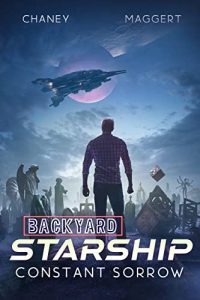 Constant Sorrow by J.N. Chaney and Terry Maggert
Constant Sorrow by J.N. Chaney and Terry Maggert
Humans have been in the stars far longer than Van originally thought, and they’ve been busy.
But not every visitor to or from Earth has good intentions, and the Peacemakers are faced with an uncomfortable reality. The Earth is about to meet aliens. Some of the aliens are bringing goods to trade. And among those items—are weapons.
When a secret cabal of humans who want to exploit the Earth is revealed, Van has to decide how and where to fight this threat. Along the way, he reveals a secret history that began in the Great War—and ends with mass chaos on his home planet.
Van won’t let that happen—at least not without a fight, and to hold back the gears of war, he’s going to need a lot of help. With Torina at his side, the crew faces a decision that will change the future of the stars themselves, and challenge the Guild, the Earth, and the Equal Grasp as the universe gets smaller with each contact between humans and aliens.
How can Van manage the clash, save earth, and deliver peace?
If he can, what will it cost him?
 I Found Puppets Living In My Apartment Walls by Ben Farthing:
I Found Puppets Living In My Apartment Walls by Ben Farthing:
Can you tell me how to get… out alive?
Johnny awakes. A puppet looms over his bed.
He recognizes the furry monster: Grandpa was its puppeteer on the children’s television show R-City Street. But Grandpa went missing a year ago. He disappeared from this very apartment building, which was converted from the old R-City Street studio.
Desperate to see Grandpa again, Johnny follows the puppet inside the building’s walls, ever deeper into a puppet-infested labyrinth…
I Found Puppets Living In My Apartment Walls is a horror tale from the “darkly inventive” purveyor of uncanny places and wondrous evils, Ben Farthing.
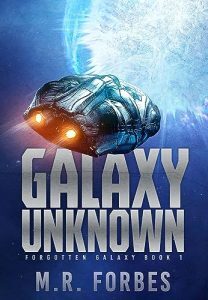 Galaxy Unknown by M.R. Forbes:
Galaxy Unknown by M.R. Forbes:
Two hundred years ago, the generation starship Pathfinder fled a war-torn Earth, never to be heard from again. Until now…
Captain Caleb Card and his crew are on a mission to investigate a transmission believed to be from the lost ship. Ambushed upon arrival, they immediately fear the worst. But the beacon isn’t only active, it’s on the move, and where it leads will change everything they thought they knew about the universe. Cast into a distant galaxy brimming with unknown dangers, they’ll need to adapt quickly if they want to survive long enough to help the missing colonists.
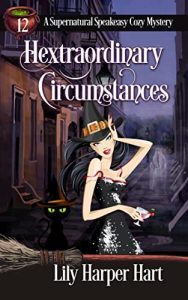 Hextraordinary Circumstances by Lily Harper Hart:
Hextraordinary Circumstances by Lily Harper Hart:
Vampires are taking over the French Quarter.
Ofelia Archer was hoping for a break, a stretch of quiet time to enjoy the opening of her brother’s new bar, but the sight of vampires walking the rooftops one evening, tracking her, makes her wary. Then, the next morning, when a body is dropped in front of a famous vampire house, things in the Quarter take a turn.
Ofelia’s dealt with vampires before, but there’s something different about this fang gang. She’s confused enough to wonder: Are they really dealing with vampires, or something else entirely?
Zach Sully, Ofelia’s fiancé and a local police detective, starts digging. It seems there’s more than one dead body afoot…and possibly a conspiracy to hide multiple deaths.
Ofelia’s team is prepared to figure out the truth, even if it means putting themselves in danger to do it. When the new enemy focuses on her father Oscar, however, Ofelia goes on the offensive.
The French Quarter is a place where things frequently go bump in the night. This fight is about to get bloody, however.
In more ways than one.
An Oregon mom is about to lose her $#!t.
It might be what the government’s been waiting for.
On the outside, Harriet “Harry” Lime is a typical American mom. But after years of packing all the lunches and picking up all the socks, she’s become a bit…off on the inside. And after stumbling upon the offensive new statue at her daughter’s school, she gets unusually angry and turns into a gigantic monster.
Now she’ll have to figure out why that keeps happening-and why some mysterious uniformed men have begun lurking around town-all while keeping up with the grocery shopping, the carpool, and all those mother@#!&ing socks.
As soon as Harriet discovers that other local women are undergoing their own amazing transformations, she faces the sudden danger of being ripped away from everyone and everything she loves. Still, she’s begun to wonder: How much of her old life-with its surplus of cleaning, cooking, and monthly cramping-does she want to hold on to, anyway?
 Medusa Falling by G.S. Jennsen:
Medusa Falling by G.S. Jennsen:
*A stand-alone adventure set in the Amaranthe universe*
“Can I ask where we’re going?”
“Someplace safe…as safe as anywhere on this broken, fallen world can be.”
A first contact encounter isn’t supposed to kick off with a dead body.
Ambassador Marlee Marano has been dispatched to Belarria as part of a Concord initiative to meet new species and build alliances. But when an assassin murders her counterpart in front of her eyes and takes her hostage, she is plunged into an alien world on the brink of collapse.
With no way to contact Concord or get offworld, Marlee’s only allies may be a shadowy band of rebels with a questionable agenda steeped in government conspiracies, mysterious genetic experiments and bloody historical grievances that threaten to boil over. The rightness of their cause is the least of her concerns, though, for she finds herself wanted for murder and hunted by all sides.
Medusa Falling is a heart-pumping sci-fi adventure that will take you on a roller-coaster ride of twists and turns as Marlee races to uncover the secrets and lies of a captivating but deadly alien culture and find a way home.
Mystic Caravan has hit Texas, and things are supposed to be quiet in Austin. The only thing of note in a city that praises itself for being weird is the nest of vampires that rules the town.
They’re not the ones wreaking havoc this time, however.
Poet Parker knows something is up when a walk near the river results in an attack from a manic man with an ax. When he disappears just as quickly as he appeared, however, she knows something magical is afoot.
It seems Austin is trapped in the clutches of a bored being, and her way of entertaining herself includes bringing urban legends to life…and unleashing them on the city.
Poet has fought every type of magic imaginable, but this one leaves her flummoxed. It’s almost as if she’s dealing with a child mentally. Magically, however, she’s dealing with a monster.
Urban legends aren’t the only thing putting Austin in an uproar. The visiting loas—both of whom are there for Poet—are also drawing attention…and from all the wrong people.
Some magics are too strong to fight. Poet is not the sort of hero who can turn her back on people in need, however. Even if it means putting herself at risk to save them.
Poet has new magic at her disposal. Now she has to learn how to use it…or they will all perish.
It’s a fight to the finish, and who will come out on the other side is anybody’s guess.
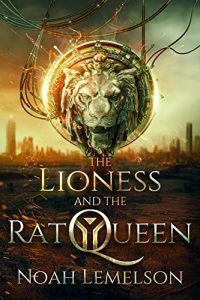 The Lioness and the Rat Queen by Noah Lemelson:
The Lioness and the Rat Queen by Noah Lemelson:
A city burning…
A murderous tycoon on the run…
And three vigilantes out for revenge…
Marcel never thought his investigations would lead to this; his once-friend Lazarus Roache turned slaver and cruel puppet master. For the good of Huile, and to salve his conscience, Marcel must take Roache down, even if that means following him into the desolate and savage reaches of the Wastes.
Yet the tycoon is not the only Wastefolk with a past with Marcel. To find the tycoon Marcel must break hardtack with an old enemy, a disgraced imperial general who he had once tried to kill, and is more than eager to return the favor. Yet she is not the greatest threat in the Wastes, for there is also a bounty hunter on his trail, the mysterious Queen of Rats, who somehow seems to know Marcel’s every dark secret.
A damaged ship, a dying shipmate–can she save them both?
Under attack! The flight back to Hyvilma should have been the easy part for the crew of the Majera–until a deadly ambush by pirates sends them reeling through hyperspace. Now getting to the planet in time is the only way Captain Kitra Yilmaz can save her dying friend.
But landing at Hyvilma may be impossible: war has broken out on the Frontier.
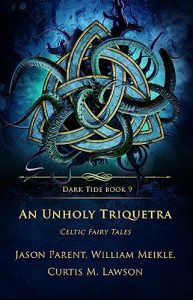 An Unholy Triquetra: Celtic Fairy Tales by Jason Parent, William Meikle and Curtis M. Lawson:
An Unholy Triquetra: Celtic Fairy Tales by Jason Parent, William Meikle and Curtis M. Lawson:
Three unique voices in today’s horror bring you new takes on an old power that threatens to reshape our world. Celtic legends are reborn within these pages, with fresh stories guaranteed to spark nightmares in the vein of Grimm’s pre-Disneyfied fairy tales.
A Knot Within A Knot by Jason Parent: A man survives a plane crash only to find himself in darker circumstances, with a winter storm on the horizon and an orphaned child in tow. An elderly woman faces off against a god of night and his steed from the confines of her airplane seat, while another hides from night and storm in the hope of a new dawn. Unbeknownst to them, their fates are linked and dependent upon the next two tales.
Bound in the Valley of Balor by Curtis M. Lawson: After surviving a plane crash, a corrupt federal agent and a mob informant find themselves stranded in a remote valley. Blood spilled during a conflict between the two awakens an ancient evil bound beneath the valley. Can either of them escape from The Valley of Balor?
Summons by William Meikle (part of hisMythos of Sigils & Totems): Would you fall slave to the rhythm?
He came to Scotland after the death of his wife in search of peace. But the old house is restless. Something is waking, something noisy, something that will not be denied.
His search for meaning in the face of ever increasing activity in the house leads him down strange occult pathways, into deep history and a story that is racing to a finish.
The rhythm calls to him. Will he fall slave to it? Or is there a path to be the drum master before it subsumes him utterly?
This Celtic horror anthology is perfect for fans of folk horror, myths and legends, supernatural horror fiction, Grimm fairy tales, and Scottish survival horror, or fans of Ritual by Adam Nevill, Bag of Bones by Stephen King, or the legendary Ramsey Cambell.
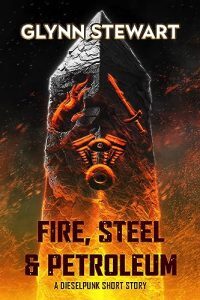 Fire, Steel and Petroleum by Glynn Stewart:
Fire, Steel and Petroleum by Glynn Stewart:
From the author of Starship’s Mage, this short, magazine-style dieselpunk story delivers on action and an Arthurian hopepunk style.
Raiders have burned the village. With innocents in danger, a Knight must stand.
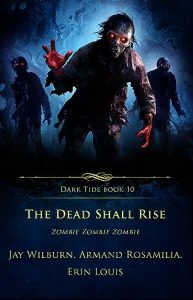 The Dead Shall Rise by Jay Wilburn, Armand Rosamilia and Erin Louis:
The Dead Shall Rise by Jay Wilburn, Armand Rosamilia and Erin Louis:
They’re coming to get you, Brave Reader.
“Prepare Because Death is Coming” by Jay Wilburn: “Take this and bear the warning.” When a messenger arrives at Dry Stretch, warning that a horde of zombies is heading their way forty years after the fall, Bay scoffs at the news. But a ‘full body’ meeting is called. Ethic is sent north to scout, but in Dry Stretch, no one is preparing. No one is repairing the walls. A William Faulkneresque story of the dead set in a dystopic dust-bowl town.
“Zombie Diner” by Armand Rosamilia: A family finds themselves on the wrong side of the zombie apocalypse while on vacation in Florida…
“Dance with the Dead” by Erin Louis: Tiffney is expecting just another night at the strip club. But when a customer goes berserk in the VIP room, things take an unexpectedly bloody turn. Stuck with a cocaine raddled manager and a shady club owner. Tiffney faces the unimaginable and is forced to turn her coworkers into allies to fight the evil that has taken over the club. Together they have to fight to stay alive.
This Zombie horror anthology is perfect for fans of post apocalyptic survival, The Walking Dead series, zombie apocalypse, and World War Z.
August 29, 2023
Indie Crime Fiction of the Month for August 2023

Welcome to the latest edition of “Indie Crime Fiction of the Month”.
So what is “Indie Crime Fiction of the Month”? It’s a round-up of crime fiction by indie authors newly published this month, though some July books I missed the last time around snuck in as well. The books are arranged in alphabetical order by author. So far, most links only go to Amazon.com, though I may add other retailers for future editions.
Our new releases cover the broad spectrum of crime fiction. We have hardboiled mysteries, cozy mysteries, small town mysteries, animal mysteries, humorous mysteries, historical mysteries, Jazz Age mysteries, paranormal mysteries, crime thrillers, psychological thrillers, political thrillers, environmental thrillers, police officers, FBI agents, private investigators, amateur sleuths, stalkers, serial killers, murdered ballerinas, crime scene cleaners, vampires, deadly weddings, deadly funerals, crime-busting witches, crime-busting socialites, crime-busting food bloggers, crime-busting grannies, murder and mayhem in London, Las Vegas, Florida, Greenland and much more.
Don’t forget that Indie Crime Fiction of the Month is also crossposted to the Indie Crime Scene, a group blog which features new release spotlights, guest posts, interviews and link round-ups regarding all things crime fiction several times per week.
As always, I know the authors at least vaguely, but I haven’t read all of the books, so Caveat emptor.
And now on to the books without further ado:
 Murder at the Funeral by Beth Byers:
Murder at the Funeral by Beth Byers:
In this short sequel to Murder on the Downs, Vi and Jack and friends return to the downs. This time to see the body of their friend interred. His killer has been found. Justice has been served. It’s time to say goodbye.
Or is it?
When they go to bury their friend, they discover the body of another man. Someone else is in Daniel Poole’s casket, and his body is still warm. What happened to their friend? Who is the killer? And who would do such a thing?
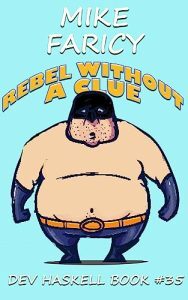 Rebel Without a Clue by Mike Faricy:
Rebel Without a Clue by Mike Faricy:
Private Investigator Dev Haskell is minding his business in the Spot Bar when beautiful Tracey Wilde walks in the door. Heads turn as she heads for Dev and enlists his help in investigating her soon to be former husband. A day later Dev gets contacted by Ernest Stanton, CEO of an investment company. Stanton wants to hire Dev to investigate a particular woman. Business hasn’t been this good in months . . . or is it? Dev takes on both new clients and quickly learns that appearances can be deceiving. Add to that the fact that Dev himself appears to be under investigation by another P.I. Can things get any crazier? Well, it’s Dev Haskell so of course the answer is yes, they can and will . . .
Better get your copy now and see if Dev can survive . . .
Most of us have a code we live by.
Some live their life altruistically, while others live by a more sinister code.
A code that only their victims know. A code to kill…
Fresh from a grueling joint operation with Spenser Song, FBI agent Blake Wilder continues to find herself being stalked and hunted down by an unknown culprit. The worst part is that they may be after her loved ones as well.
Still unable to identify her stalker, Blake meets up with Kit at a coffee shop.
There Kit gives Blake crucial intel about an arms dealer, with advanced weaponry.
A dealer that’s on a bloodthirsty path, a path that claimed the life of someone close to Kit. As Blake and her team investigate the case, they uncover a web of aliases, and a cryptic code name with a string of deaths connecting to it.
Dirty bombs, advanced weaponry, and a trail of silent victims.
Who is this elusive arms dealer? As Blake races against time to unmask the truth.
The only thing that is certain is this weapons dealer is on a path of bloodshed.
And killing is not just a choice, it’s the only code they live by…
 Hextraordinary Circumstances by Lily Harper Hart:
Hextraordinary Circumstances by Lily Harper Hart:
Vampires are taking over the French Quarter.
Ofelia Archer was hoping for a break, a stretch of quiet time to enjoy the opening of her brother’s new bar, but the sight of vampires walking the rooftops one evening, tracking her, makes her wary. Then, the next morning, when a body is dropped in front of a famous vampire house, things in the Quarter take a turn.
Ofelia’s dealt with vampires before, but there’s something different about this fang gang. She’s confused enough to wonder: Are they really dealing with vampires, or something else entirely?
Zach Sully, Ofelia’s fiancé and a local police detective, starts digging. It seems there’s more than one dead body afoot…and possibly a conspiracy to hide multiple deaths.
Ofelia’s team is prepared to figure out the truth, even if it means putting themselves in danger to do it. When the new enemy focuses on her father Oscar, however, Ofelia goes on the offensive.
The French Quarter is a place where things frequently go bump in the night. This fight is about to get bloody, however.
In more ways than one.
 Friday in Las Vegas by Kaye Hopkins:
Friday in Las Vegas by Kaye Hopkins:
When Isabel Morgan washes out of the police academy because of a deeply humiliating trait she wasn’t aware of (she can’t fire a weapon without closing her eyes), she discovers the world of crime and trauma scene cleaning. Enlisting the help of her roommate, Kenny Diaz, she starts her own cleaning business.
One of Izzy and Kenny’s first jobs is a possible murder/suicide at The Kingdom Hotel and Casino in Las Vegas, Nevada. As it turns out, this is one of her father’s cases. He is a homicide detective with the Las Vegas Metropolitan Police Department and wanting to be closer to her dad and his world, Izzy begins her own investigation—an investigation that puts her in the sights of one violent and vindictive security guard. But when she’s kidnapped and thrown into a dungeon-like room at the casino, she finds that guard beaten up and half dead.
So, who is the real enemy here? Could it be Devlin Russo the young handsome manager of The Kingdom with possible mob connections and the man she’s just fallen for? Could it be someone she hasn’t even met yet? And is she going to end up in the same condition as the security guard or are they both going to die, buried beneath tons of concrete, in a room where no one can hear you scream?
 Emily Lickenson Could Not Stop Death by CeeCee James:
Emily Lickenson Could Not Stop Death by CeeCee James:
Join Emily Lickenson, the cat food blogger with a knack for finding trouble, in her latest cozy mystery adventure.
Emily had hoped to settle back into her peaceful routine after helping to solve the last crime spree, but fate had other plans. When she stumbles upon a murder victim in the alley behind her apartment building, she knows she can’t ignore her instincts.
However, Emily soon discovers the police aren’t interested in solving the crime, and no one is willing to talk. Does this unsettling silence have something to do with the victim? Who was he? And why is everyone being so secretive?
With the help of her trusty sidekick, Shakespeare, and Aunt Mattie, who’s dealing with the fun challenges of an adorable new foster pet, Emily dives headfirst into the investigation. Can she uncover the truth behind the murder, or will the crime remain unsolved? This delightfully gripping whodunit will keep you guessing until the very end, making it a must-read for all cozy mystery lovers.
 Murder in the Chapel by Sonia Parin:
Murder in the Chapel by Sonia Parin:
To love and to cherish, til death us do part…
Returning from town, Evie, the Countess of Woodridge, and Tom Winchester find the village buzzing with excitement. Finally, they are getting married and everyone is thrilled and eagerly awaiting the day to celebrate the long awaited nuptials.
While they play host to wedding guests arriving from near and far, they each deal with their wedding jitters, even though they know nothing and no one will stand in their way.
… anyone present who knows a reason why these persons may not lawfully marry…
If anything can interfere with their wedding plans it is bound to be something quite ominous. Something along the lines of a dead body discovered in the crypt inside the Woodridge family chapel where Tom and Evie have been practicing the wedding ceremony.
A body with a gunshot wound to the heart.
The weapon is found and provides unquestionable proof of guilt.
The Countess of Woodridge’s guilt.
There are places in this world where you can enter, but never leave…
After witnessing and helping to solve many cases with FBI agent Emma Griffin, PI Dean Steele should get an honorary FBI badge as a reward.
With Fall and its festivities rapidly approaching, Dean gets an urgent call.
Four years ago, in the quiet town of Harper, three teens were murdered against the backdrop of Halloween.
Their body parts were found in the most bewildering way.
The body count has now risen and there are still no answers.
When the family of the first victim hires Dean to get to the bottom of it, he is plunged in a dark and terrifying web of secrets.
Now, it’s up to Dean to learn who the true Hallows Eve killer is before he builds another scarecrow out of his victim
When ballerina Lydia Miseau dies onstage in the final dress rehearsal of Romeo and Juliet, homicide detective Caitlin O’Connor is faced with the most complicated case of her career. She strongly suspects that someone murdered the ballerina, and her investigation uncovers several people close to the star who had reasons to kill her. But the autopsy reveals no apparent cause of death. If Lydia Miseau was murdered, who did it, and how?
Meantime, there’s Caitlin’s hot mess of a personal life. She has a bad habit of getting involved with married men. She knows it’s wrong, so why does she keep entangling herself in unhealthy relationships? She’s finally decided to go into therapy to find out.
 Shadow’s Conspiracy by Mary Stone:
Shadow’s Conspiracy by Mary Stone:
Not every conspiracy is a theory.
When a man washes up onto Shadow Island, Sheriff Rebecca West has a moment of déjà vu. This isn’t the first body the ocean spat out on one of her beaches, but it’s the first one she’s found alive.
Barely.
The brutal gunshot wounds to the victim’s hand and the lower part of his face indicate he was shot offshore and dumped overboard, but there’s no boat or perpetrator. Just a few cryptic clues before the victim becomes unresponsive.
At first glance, the investigation points to pirates or a drug deal gone bad. But as Rebecca delves deeper, she realizes that this is far more than an attempt on a low-level criminal’s life. The case stretches out its tendrils, entangling the esteemed members of Shadow Island’s Select Board, the sinister Yacht Club, and even her own sheriff’s department.
And it could jeopardize everything.
Blackmail, power, and corruption collide as Rebecca resolves to clean the island up once and for all. Unless she dies trying.
 Arctic Inferno by Geza Tatrallyay:
Arctic Inferno by Geza Tatrallyay:
Arctic Inferno, the sequel to Arctic Meltdown, is a timely and gripping international environmental thriller set against the background of the devastation of climate change and the melting of the polar ice cap. The heroine, Hanne Kristensen, the beautiful Danish geologist appointed Minister of the Environment and Natural Resources for the newly independent Greenland, has to maneuver through a wave of setbacks to foil both a Chinese attempt to control Greenland’s natural resources and a more aggressive Russian attempt to gain hegemony over the sparsely populated fledgling country as well as to save her friend, the ousted Premier of Russia, Pavel Laptov. Her suitor, Canadian diplomat Richard Simpson, aids her in this process as well as in the design and signing of a new and more environmentally focused Arctic Treaty to save the region from complete environmental catastrophe. But at the same time Hanne’s private life is complicated by this relationship, as she has to choose between Richard and her long-time lover and childhood friend, Kristi Olafson. This is an action-packed novel with lots of twists and turns guaranteed to keep the reader at the edge of their seats, but also one that brings home the realities we could be living in the very near future.
 Pineapple Maids by Amy Vansant:
Pineapple Maids by Amy Vansant:
Pineapple Port retirees Mariska and Darla have been many things to Charlotte Morgan—surrogate mothers when her grandmother passed, belly-fillers (almost constantly), and dime-store decorators when the new Charlock Holmes Detective Agency needed upgrading…
All they ask in return is one teeny, tiny, itty-bitty thing in exchange…To go undercover so they can find out who’s killing residents at a high-end assisted living manor.
What could go wrong if Darla and Mariska masquerade as residents? Or war with the manor’s “mean girls?” Or start a revolt via talent show?
Charlotte doesn’t have time to worry about the ladies. She’s and Declan are posing as staff, and they’ve got secret gardens, scary alligator prints, and poison tea to worry about. They’ll have to hurry—one of the residents just laughed himself to death while painting a cheeky art reproduction…
Will Dead Ed be the manor’s last casualty?
Grab some cookies and find out! (Just don’t drink the tea…)
Cora Buhlert's Blog
- Cora Buhlert's profile
- 14 followers



